What is ecommerce marketing? A complete beginner’s guide
New to ecommerce marketing? Learn what it is, how it works, and the key channels and strategies to grow your online store and drive consistent sales.
Ecommerce brands in 2025 need a system that connects acquisition, conversion, retention, and analytics. Growth depends on turning traffic into purchases, building customer loyalty, and using data to improve performance over time.
Ecommerce marketing enables this process. It combines strategies and tools to attract potential customers, convert them into buyers, and keep them coming back.
Statista projects global retail ecommerce revenue will exceed $4 trillion in 2025. The size of your share depends on how effectively you execute across the customer journey.
This article covers the four pillars of modern ecommerce marketing. You’ll find tactical examples, actionable ideas, and tools that can help you apply these strategies to your online business.
What is ecommerce marketing?
Ecommerce marketing is a strategy for driving traffic, increasing sales, and growing customer lifetime value. It uses both paid and organic tactics to support every stage of the buyer journey.
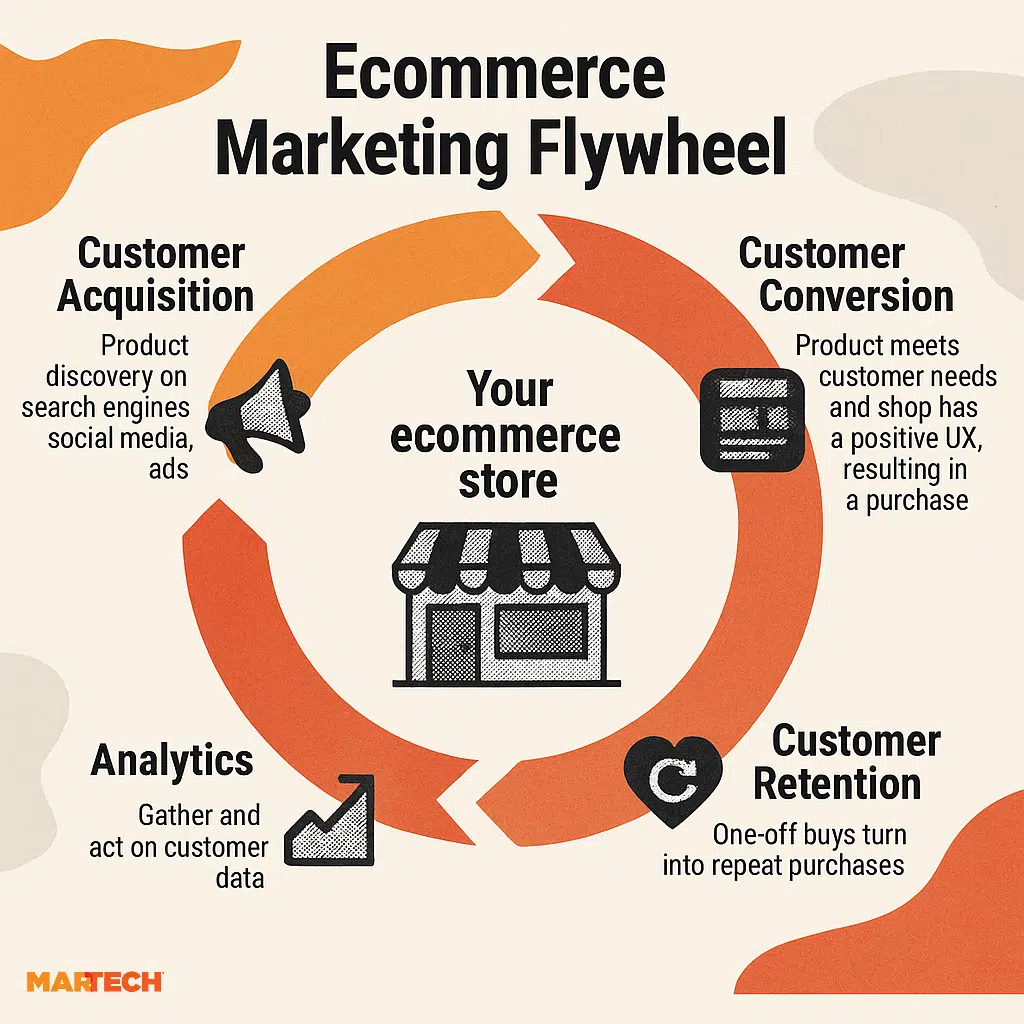
A well-rounded ecommerce marketing plan addresses four areas:
- Customer acquisition: Reaching your target audience and bringing in new visitors through search, ads, and social platforms
- Retention: Encouraging repeat purchases through personalized outreach
- Loyalty: Strengthening the relationship with long-term customers
- Experience: Creating the best experience possible for new and loyal customers alike
Many marketers focus heavily on website traffic. Without systems to convert and retain customers, traffic alone doesn’t generate meaningful growth.
Challenges
Digital marketers face rising competition, changing data laws, and increasingly complex customer journeys. Brands must adapt their ecommerce marketing strategies to account for privacy regulations, fragmented channels, and increasingly cautious consumers.
Key challenges of ecommerce in 2025 include:
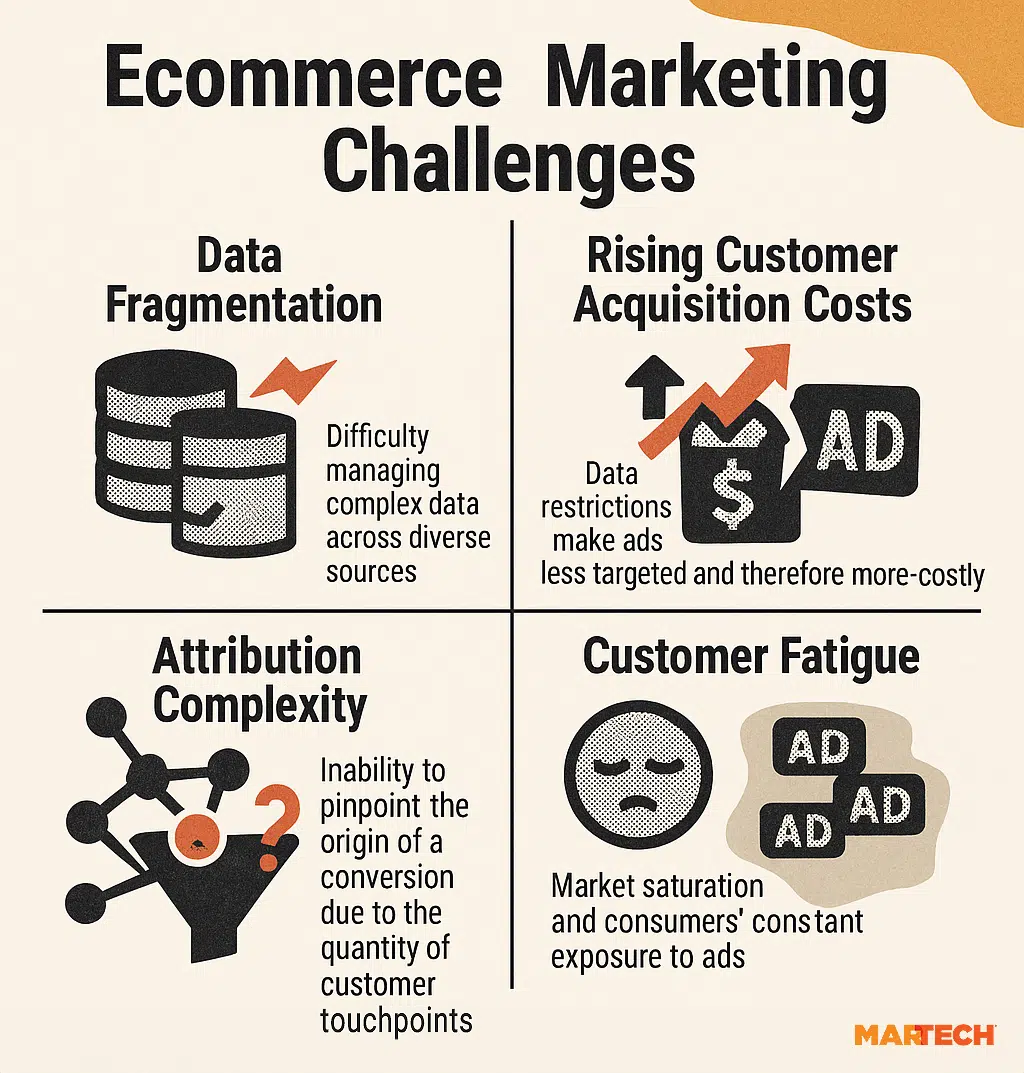
Modern ecommerce growth depends on addressing these issues directly. A data-informed strategy that spans acquisition through loyalty is essential for long-term performance.
Pillars of modern ecommerce marketing
Ecommerce growth depends on a system that improves with every cycle. When executed well, these four pillars form a flywheel that drives sustainable results:
- Acquisition
- Conversion
- Retention
- Analysis
Each phase informs the next, creating a continuous loop of optimization. Let’s start with acquisition.
Your Attribution Model is Missing 40% of Brand Discovery
✓ Track brand mentions across all AI search platforms in real-time
✓ Connect AI-driven discovery to your existing analytics
✓ Measure sentiment and accuracy of every AI mention
Enterprise-grade AI tracking. Finally.
Acquisition
Customer acquisition brings new visitors to your ecommerce site. With rising customer acquisition costs (CAC) and tighter data privacy regulations, brands need smarter targeting and a diversified mix of channels.
Common ecommerce customer acquisition channels are:
- Search engine optimization (SEO): Earned visibility in organic search results across platforms like Google, YouTube, and Pinterest.
- AI referrals: Organic mentions from AI tools like ChatGPT when users ask product-related questions.
- Paid search placement (SEM): Keyword-based paid ads at the top of specific search engine ranking pages (SERPs), e.g., Google Ads.
- Influencer marketing: Sponsored product endorsement and placement in front of an influencer’s audience.
- Social media ads: Paid placement on social media platforms, often leveraging pixel data and third-party tracking (though this data is now less reliable since Apple’s tracking update and broader cookie depreciation).
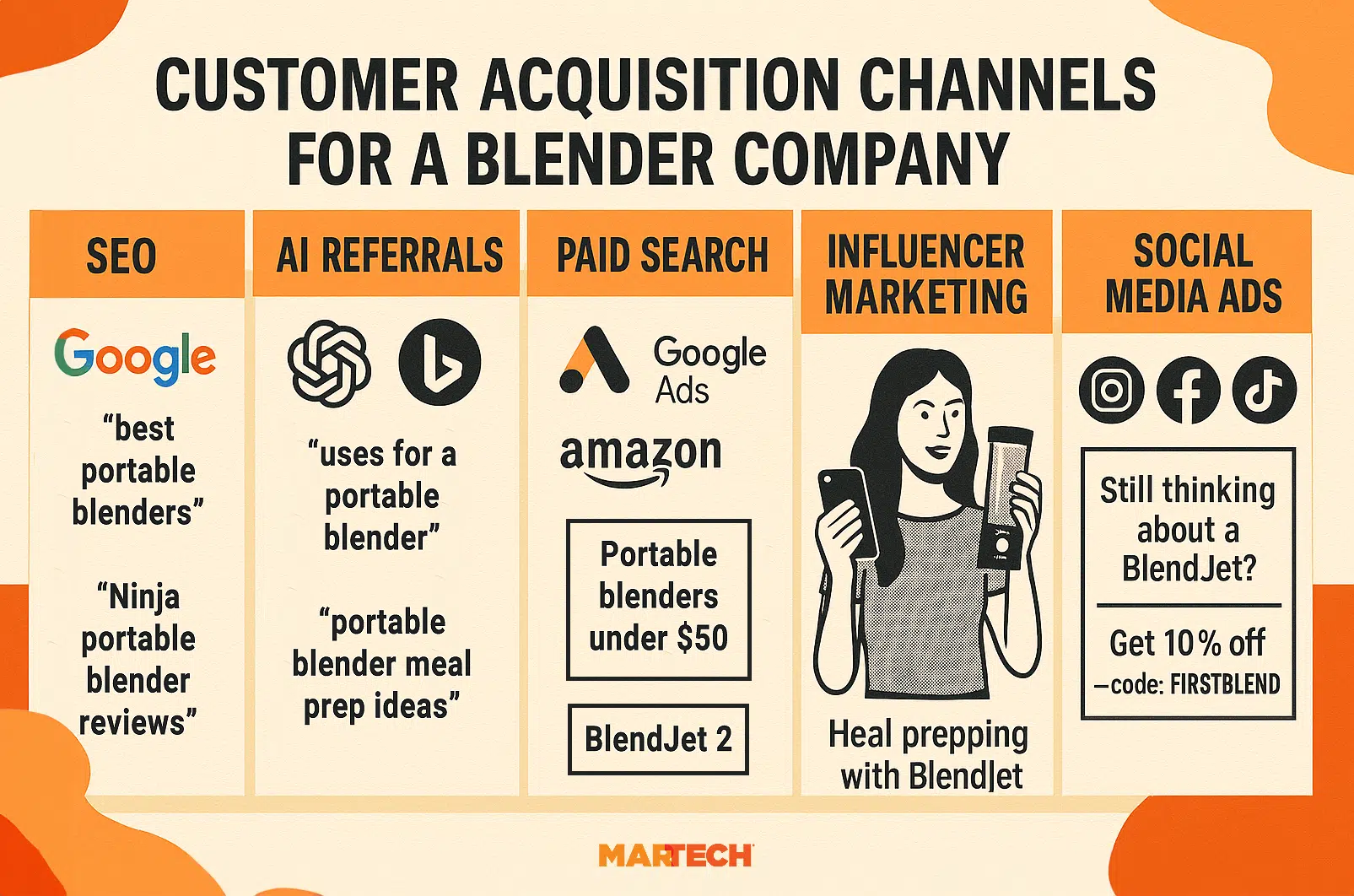
Acquisition is just the first step. To generate revenue, you also need to convert visitors into buyers.
Conversion
To drive revenue, ecommerce brands must convert traffic into paying customers. This process, called conversion rate optimization (CRO), focuses on removing friction and building trust throughout the buyer journey.
Conversion rate is calculated by dividing the number of purchases by the number of site visits, then multiplying by 100.
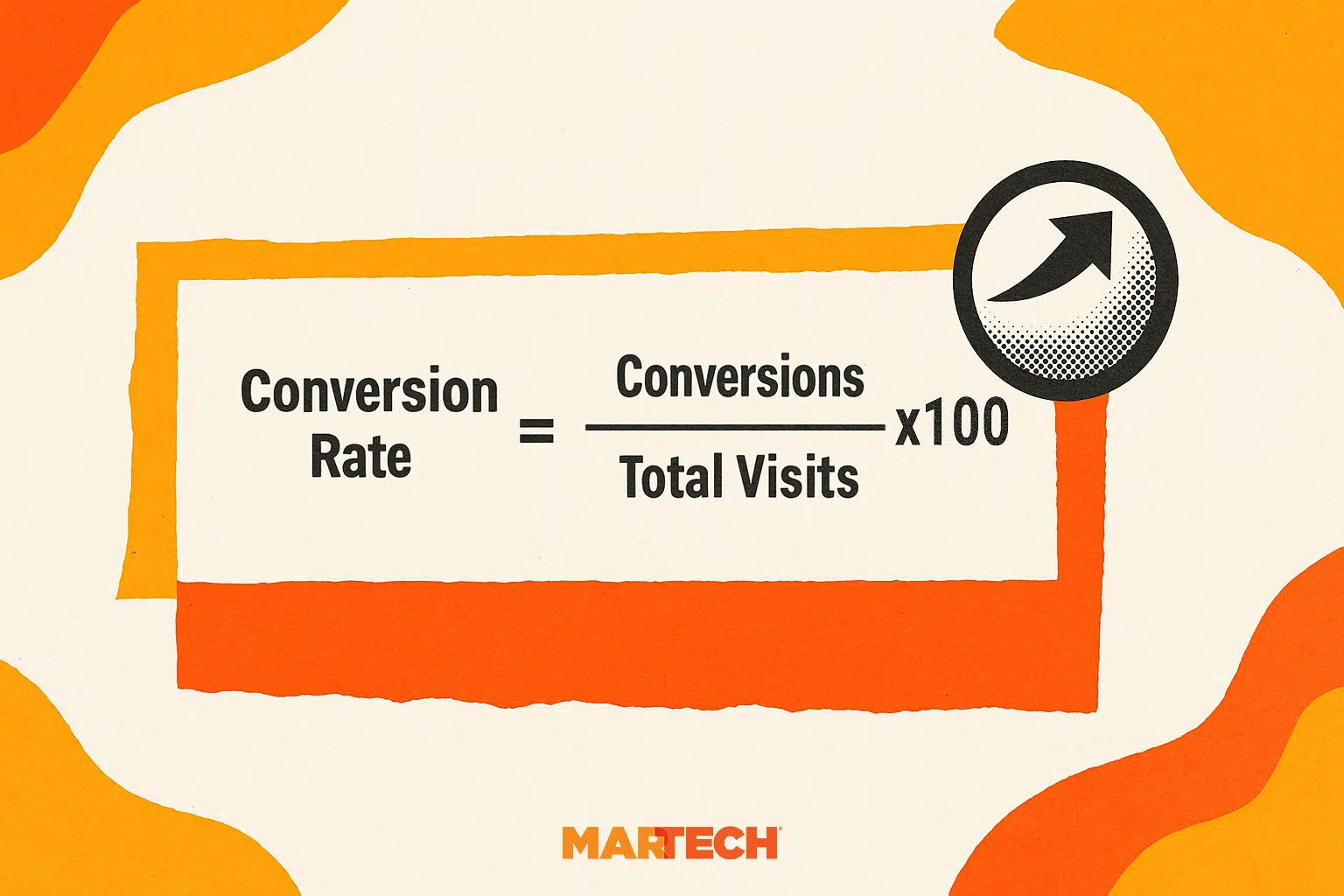
The average ecommerce conversion rate is under 4%, which means most visitors leave without buying. Optimizing product presentation, site experience, and trust signals is essential for improving that number.
One of the most effective ways to improve conversion is through strong merchandising. In ecommerce, that means how you group, display, and describe your products, especially on product detail pages (PDPs).
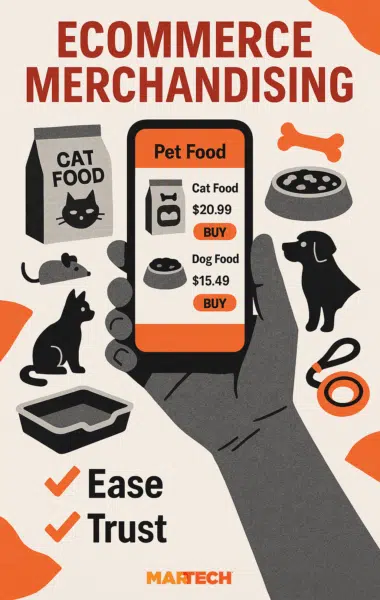
Optimized PDPs should:
- Highlight features in product descriptions with clear, scannable copy
- Include technical details that support purchase decisions
- Reinforce trust through reviews, guarantees, or user-generated content (UGC)
- Use visuals that reflect real use cases
- Offer product recommendations wherever possible and appropriate
CRO also depends on overall site usability. Fast load times, mobile-friendly layouts, and intuitive navigation all contribute to higher conversion rates.
Whether you’re launching a new storefront or scaling an enterprise ecommerce operation, CRO is a critical pillar of long-term growth.
Retention
Retaining customers is more cost-effective than acquiring new ones. Strong retention strategies increase repeat purchases, improve customer lifetime value (LTV), and reduce dependency on short-term discounts.
Common retention tactics include:
- Email and SMS marketing: Lifecycle flows, post-purchase check-ins, and cart abandonment reminders
- Loyalty and referral programs: Points, credits, or incentives for repeat purchases and referrals
- Subscriptions: For replenishable products, subscriptions drive predictable revenue and engagement
A strong product is the foundation. Once that’s in place, brands can build trust and loyalty through direct communication, positive customer experience, and value-based incentives.
This is where permission-based marketing plays a key role. Customers opt in to receive messages, often incentivized by a discount, and then engage with ongoing, personalized outreach. Done well, this replaces constant promotions with long-term loyalty.
For example, jewelry brand Hello Adorn uses email to nurture relationships beyond the transaction.
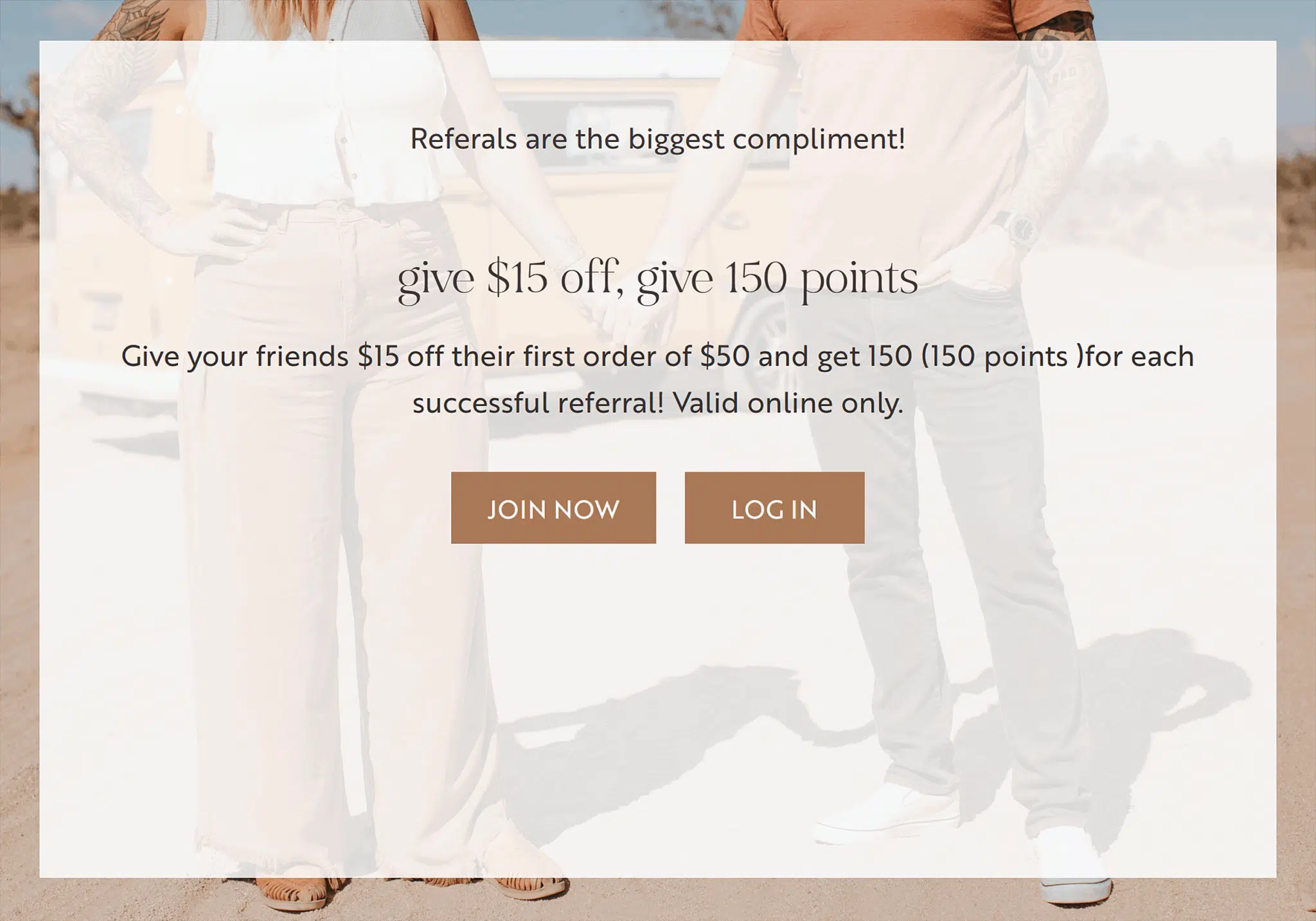
Their post-purchase messaging provides styling tips, gift ideas, and updates on product drops. Instead of pushing discounts, the brand builds community, encouraging customers to return because they feel seen and valued.
Not every business has high retention potential (e.g., a shop that only sells wedding stationery), but for most ecommerce brands, retention is a key growth lever.
Analysis
Ecommerce analytics help brands identify what’s working and where to improve.
- Average order value (AOV) supports short-term decisions by showing how much customers spend per transaction.
- Customer lifetime value (LTV) informs long-term strategy by measuring revenue potential across a customer’s full relationship with the brand.
To get meaningful insights, brands need a unified view of the customer journey, which is increasingly difficult in today’s privacy-first environment. Data is fragmented across devices, platforms, and campaigns.
That’s where attribution modeling comes in. Attribution modeling helps determine which marketing touchpoints contribute to conversions. But modern attribution is more complex due to:
- Cross-device and multi-touch behavior
- Signal loss from privacy regulations (e.g., limited third-party tracking)
- The difficulty of separating awareness-driving actions from conversion-driving ones
For example, brands can track website visits and email opens. But they can’t track every time ChatGPT recommends a product, or when a user talks about a brand in a private message. These invisible touchpoints make it harder to understand performance and assign ROI accurately.
To close these gaps, many ecommerce marketers use tools like Triple Whale, Northbeam, or GA4 to consolidate insights and improve attribution. These marketing tools help inform decisions across acquisition, retention, and budget allocation.
Clear, connected analytics are critical to sustaining profitable ecommerce growth.
Paid customer acquisition
Paid customer acquisition allows brands to reach a wider audience. It’s often (but not always) expensive. It can be highly effective with the right targeting. Here’s a quick framework, with more explanation below:
- Meta Advantage+ for retargeting
- Google Shopping for products with keyword volume
- Influencer marketing for new products
Let’s start with the ad platform everyone loves to hate: Facebook.
Meta (Facebook ads)
Despite data and privacy setbacks, Meta ads are still a popular and beginner-friendly ecommerce advertising choice for ecommerce businesses. Especially with Meta Advantage+, Facebook’s AI-powered campaign tool.
Within the Facebook Ads Manager interface, ecommerce brands can select the “Sales” objective

Then, Advantage+ automatically streamlines campaign setup.

Seasoned Facebook advertisers note that there are pros and cons to this new era of Meta advertising, but specifically cite the promise for ecommerce businesses.
Advantage+ followed Apple’s industry-shifting iOS 14.5 update in 2021. This featured App Tracking Transparency, which led most users to decline app tracking.
This restriction on Apple’s Identifier for Advertisers (IDFA) ended a data-rich era of online advertising, requiring platforms and advertisers to adapt.
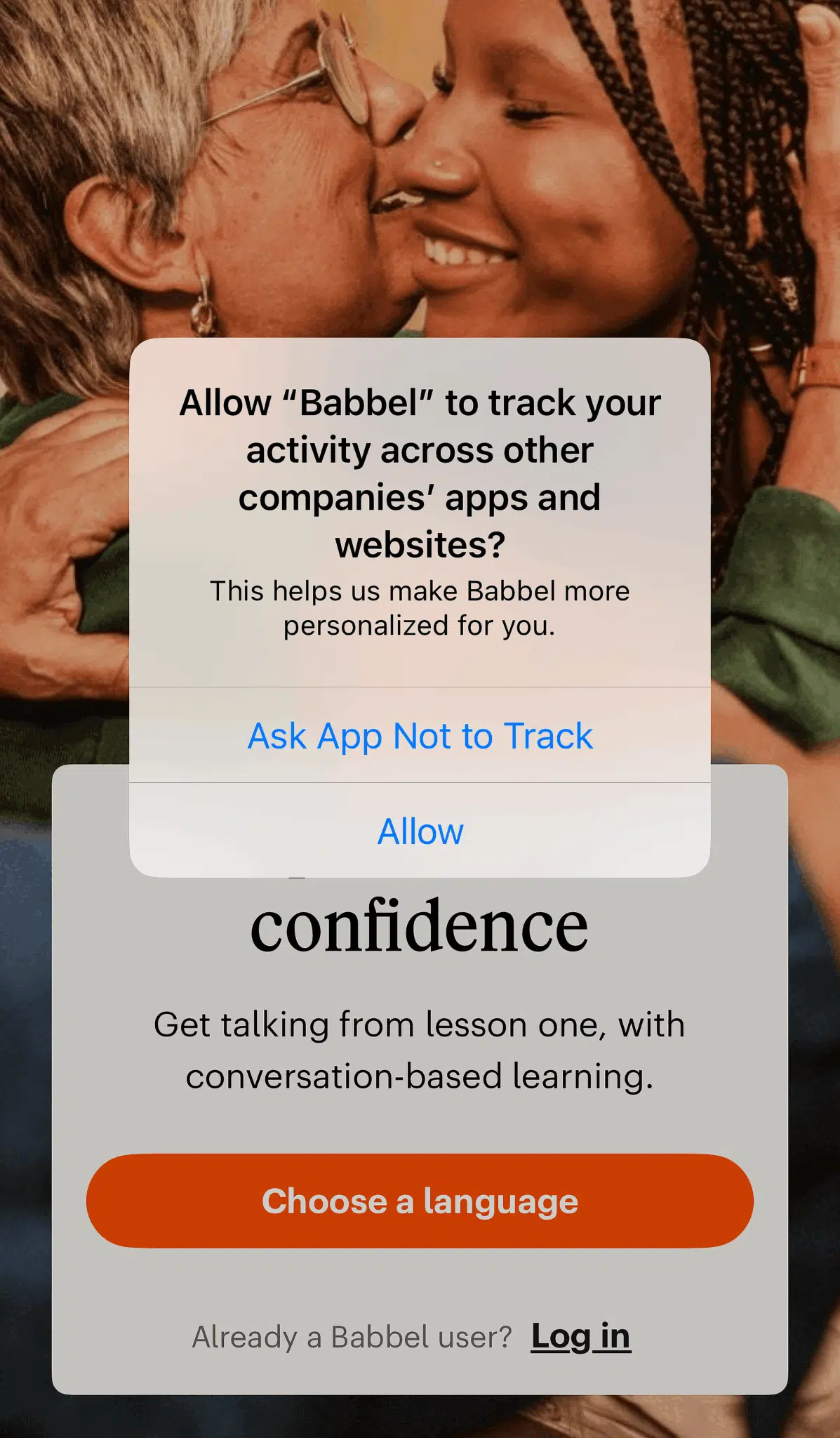
Google Shopping and Performance Max
Google ecommerce advertising has two forms: paid placement in search (Google Shopping) and advertising across applications (Performance Max).
Google’s searchable product listings, called Google Shopping, help users browse the millions of products for sale. Being listed organically in these search results is free, just like all Google search results.
But prime placement is reserved for paid ads. This is a pay-per-click (PPC) model.
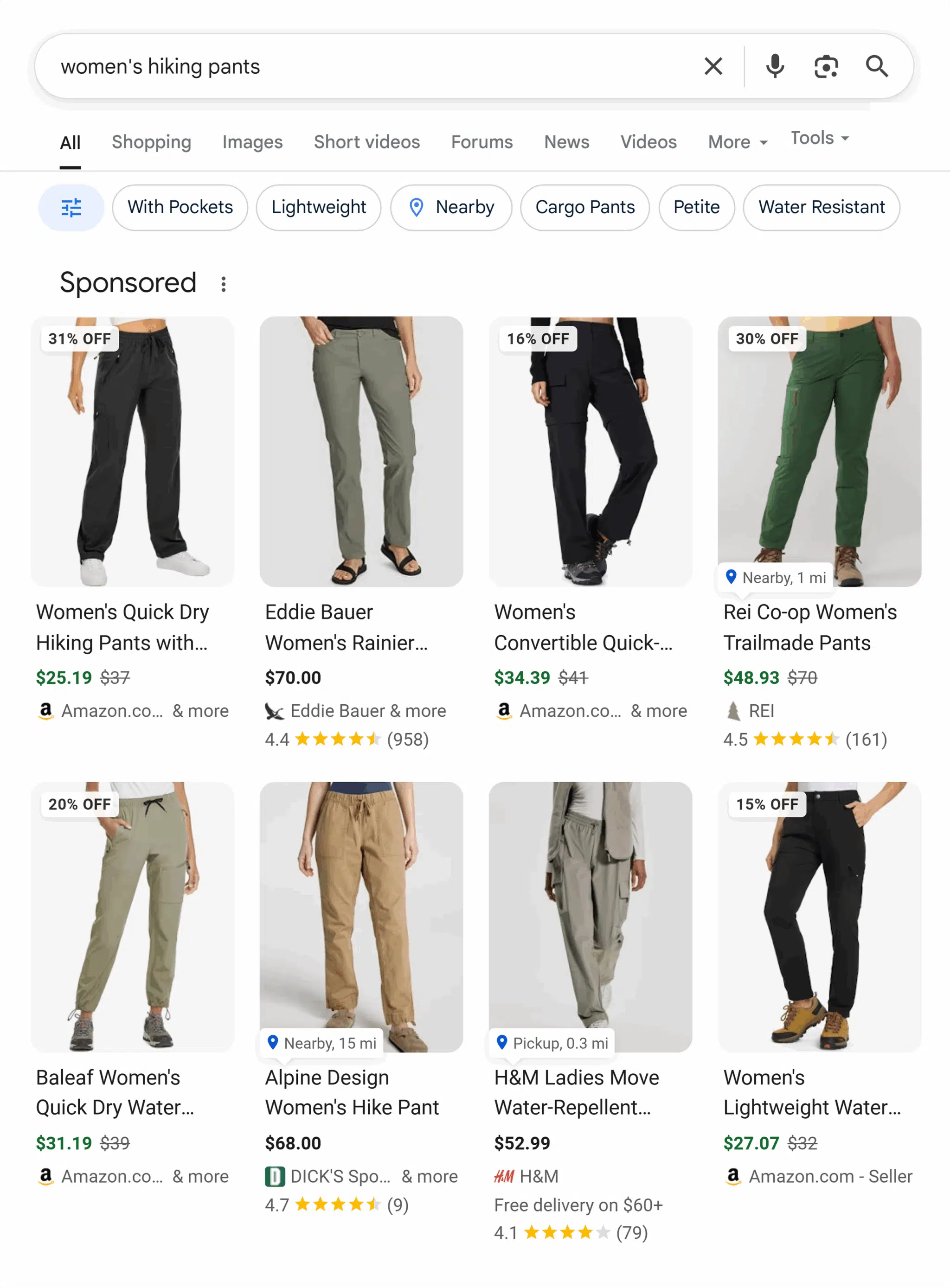
Performance Max goes beyond search. It distributes ads across Google’s full suite of apps, including YouTube, Gmail, Maps, and Search, through one campaign.
These placements blend into each app’s experience, and users often don’t realize they’re interacting with paid content.
For example, Gmail ads appear natively in inboxes. This makes them less distinguishable from regular emails, with many users unaware they’re being exposed to paid marketing in their inbox.
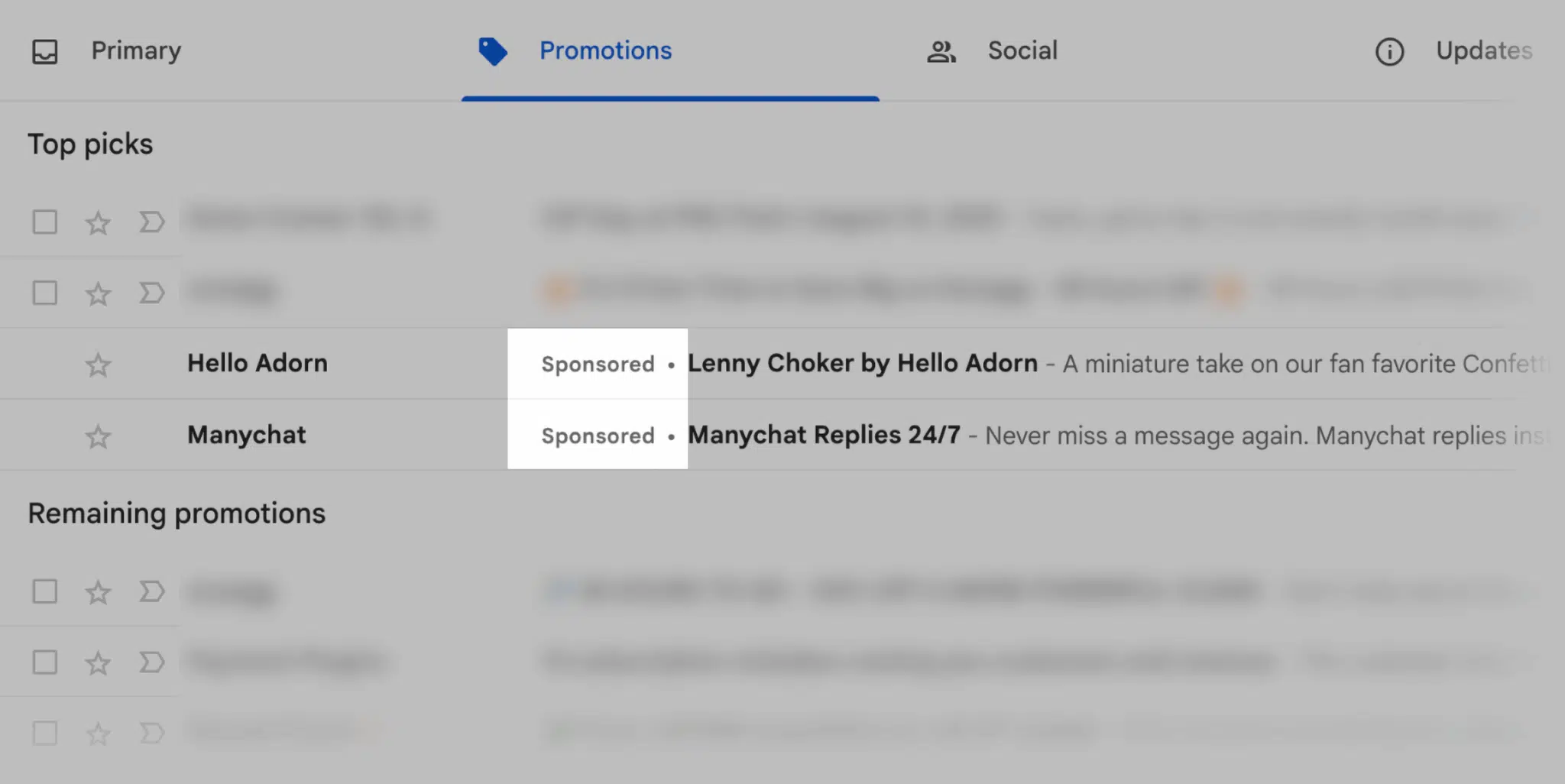
TikTok and YouTube
TikTok and YouTube are powerful retargeting opportunities thanks to their wide top-of-funnel reach.
Advertisers can wait for a new viewer to enter the discovery phase, like watching a short video about their product. Then, after product awareness has been established, follow up with a retargeting ad.
Influencers and UGC
Real customers showing how they authentically use a product is generally more persuasive than company marketing.
This is a social-media spin on word-of-mouth referrals. It falls into two main categories:
- UGC (user-generated content): Content created by customers and shared on social media posts
- Influencer marketing: Collaborating with creators who have amassed a following on social media
Influencer marketing is effective because of the relationship and trust influencers have built with their audiences.
Users who follow influencers enjoy consuming their content. An example of this is videographer Grace Wells, who makes entertaining commercials for products that her audience enjoys watching.
Brands can run ads to UGC published by influencers. This is called influencer whitelisting.
UGC can also be added directly to a product page. Research by Yotpo found that ecommerce pages with UGC had a 161% higher conversion rate than pages without. Here’s an example from Target:
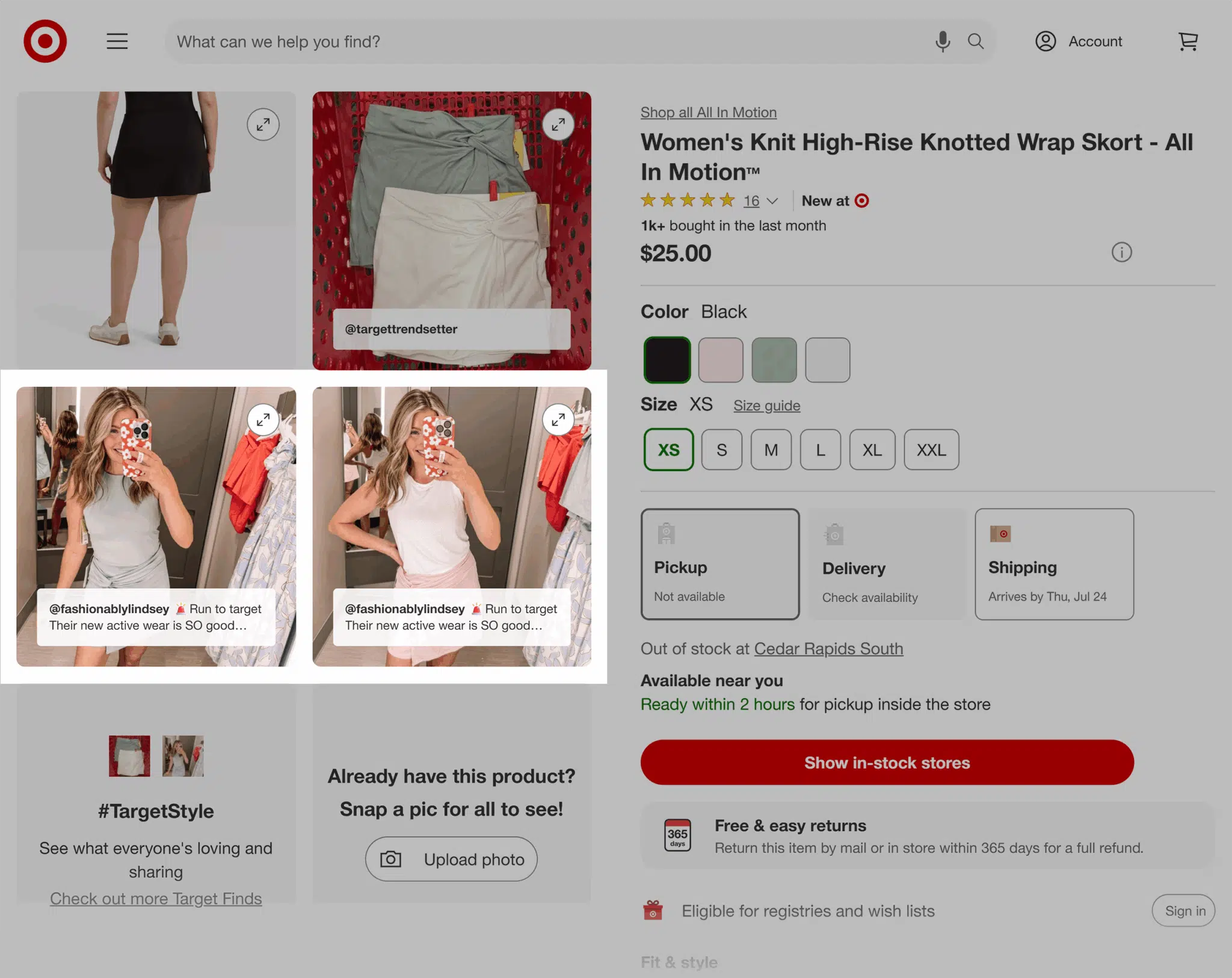
Strategic campaign structures
Not all campaign types lend themselves equally to different points of product awareness. The most effective campaigns will strategically choose an ad type that complements where the product is in its lifecycle.
For example, “discovering” new products is integral to social media influencing. This is how influencers provide value to their audience. And brands want their products in front of new audiences, so this is symbiotically beneficial.
Here’s a starting framework for campaign structure in relation to product lifecycle:
- Introduction: Focus on top-of-funnel content to build awareness. Consider influencer marketing and viral organic content.
- Growth: Focus on differentiators to sway on-the-fence viewers. Consider paid ads and SEO.
- Maturity: Focus on retention to maximize LTV. Consider loyalty programs and partnerships.
- Decline: Focus on repositioning to reengage. Consider retargeting and bundles.
Here’s an example campaign between public figure Haben Girma and Apple. This campaign strategically built awareness and buzz about a new feature in Apple’s upcoming product release.
@haben.girma Apple gave me early access to their groundbreaking AirPods Pro 2 hearing aids, and the chance to talk to Vice President of Health Dr. Sumbul Desai and Director of Global Accessibility Policy and Initiatives, Sarah Herrlinger. Designed for adults with mild to moderate hearing loss, these over-the-counter hearing aids provide an easy way to explore your hearing health at a place and pace of your choice. A software update next week will make them available to the public, transforming AirPods Pro 2 into one of the most affordable and powerful hearing aids in the world. Read the descriptive transcript on my website: habengirma.com (link in bio). #Airpods #a11y #Accessibility #HealthTech #HearingAids ♬ original sound – Haben Girma
Each ad campaign should meet the product where it’s at in its lifecycle.
The product needs to meet viewers where they’re at, too. Observe seasonal ebbs and flows to understand predictable advertising opportunities. This is known as seasonal intent.
Audience segmentation and testing
Paid advertising yields the best results when it’s targeted to your ideal demographics, then tested and refined. Audience segmentation is key in making that happen.
Segmentation becomes increasingly complex with the collection of more customer data. But it can start small, with just two segments: new visitors and returning visitors.
Retargeting past website visitors is one of the most basic and widely used forms of segmentation.
For example, visiting Bite’s website triggered a retargeting ad on Facebook within minutes.
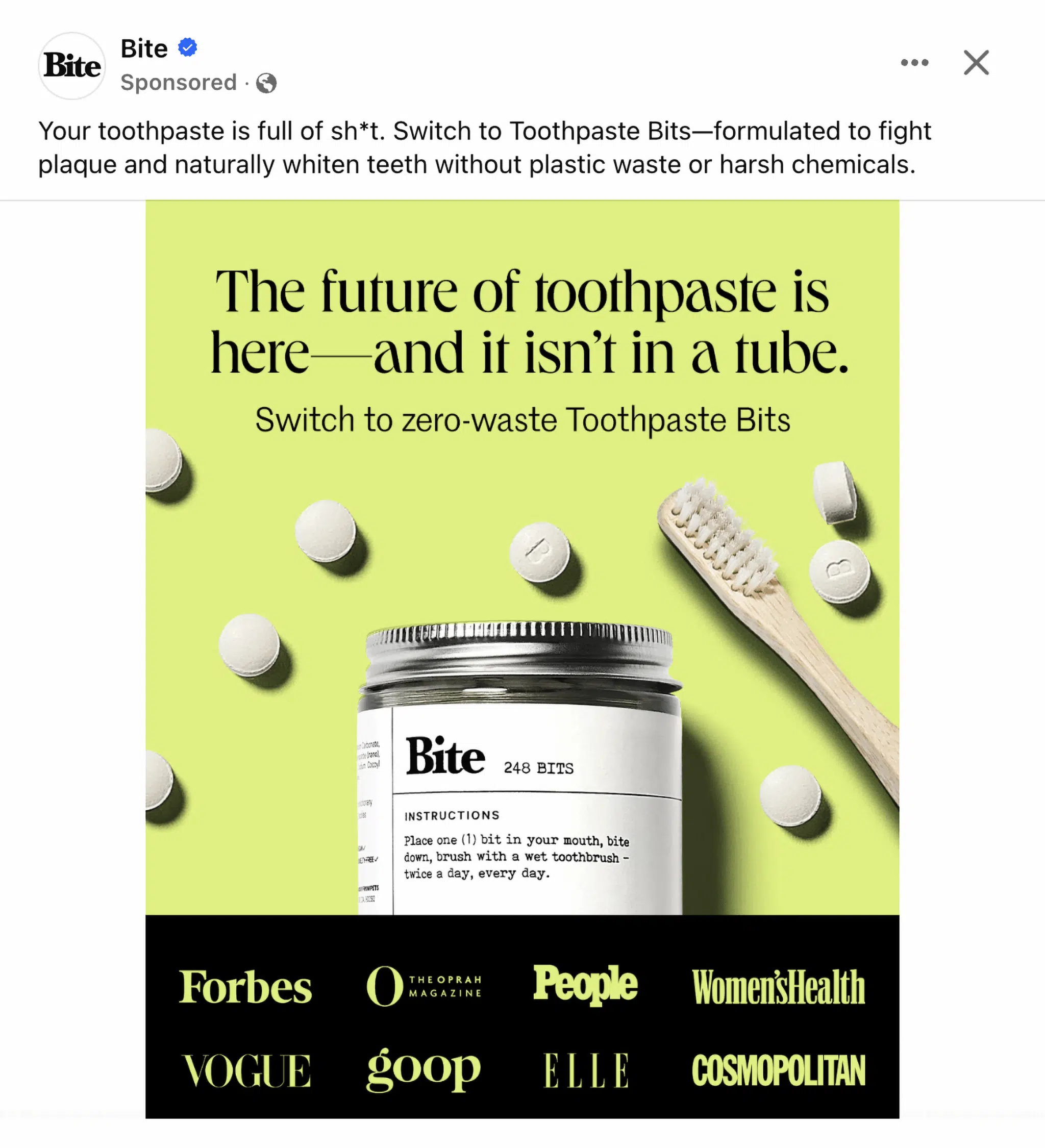
These acquisition strategies are all paid—they’re complemented by organic acquisition.
Organic customer acquisition
Organic customer acquisition requires an investment, but it has a longer lifespan than ads. Primary drivers are search engines, social media, and brand recognition. AI is also growing as an ecommerce referral powerhouse.
SEO for ecommerce
Applying search engine optimization (SEO) to your ecommerce store will enable your products to show up in search engine results pages (SERPs). Ranking in search results is never guaranteed, but a comprehensive SEO strategy improves ranking chances.
This is a detailed process that’s achieved through on-page, off-page, and technical SEO. At a glance, some important considerations are:
- Category page optimization: Communicates page contents to search engines through metadata, headings, URL structure, keywords, etc.
- Structured data: Adds code to product pages that communicates information like product material, price, reviews, FAQs, etc.
- Faceted navigation: Allows users to filter products based on size, color, etc.
- Crawl depth: Refers to how many clicks away from your homepage a product page is.
You can see some of these optimization efforts (URL, headings, and metadata) from Google’s interface:
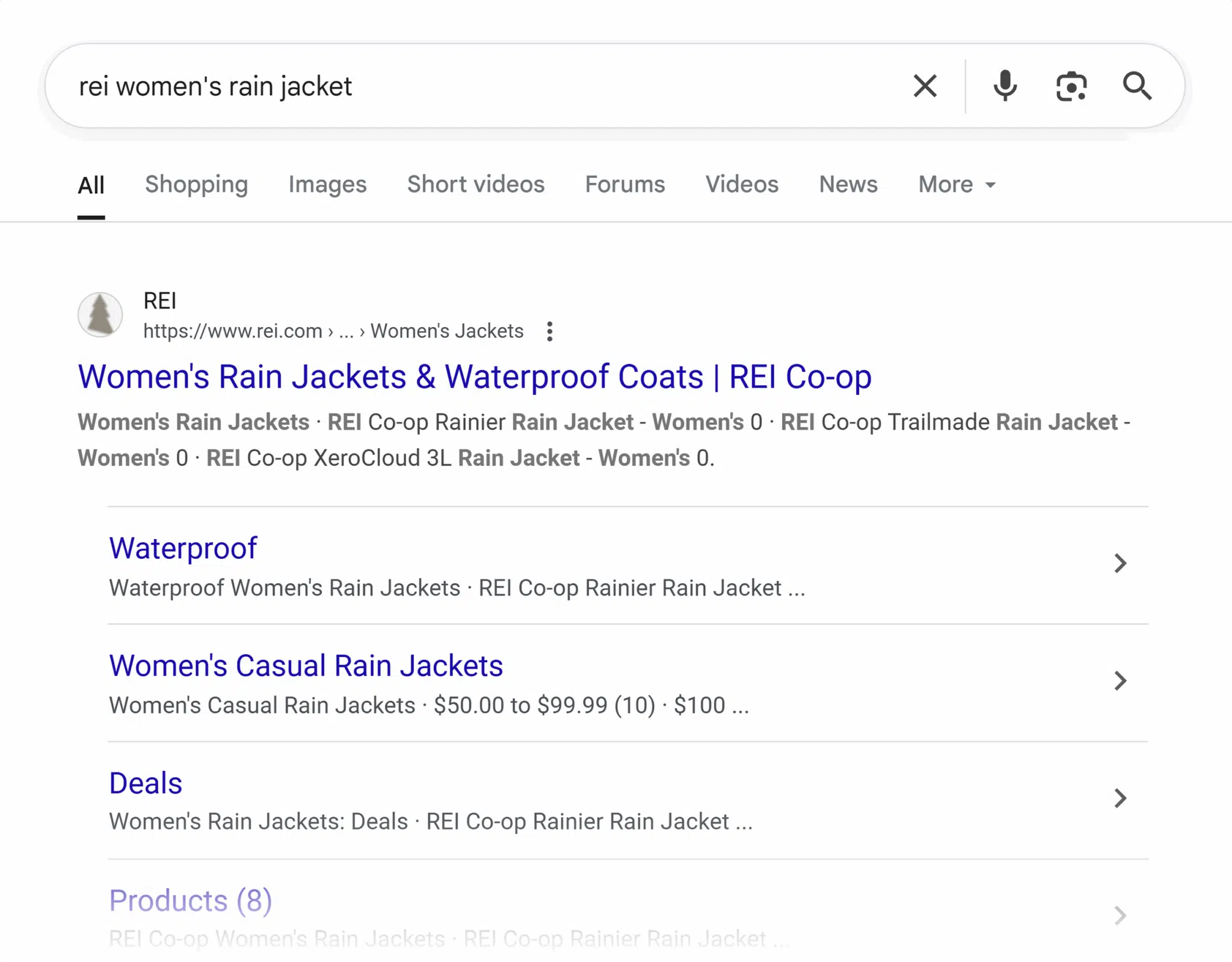
When you inspect the code on the page, you can see some of the structured data:
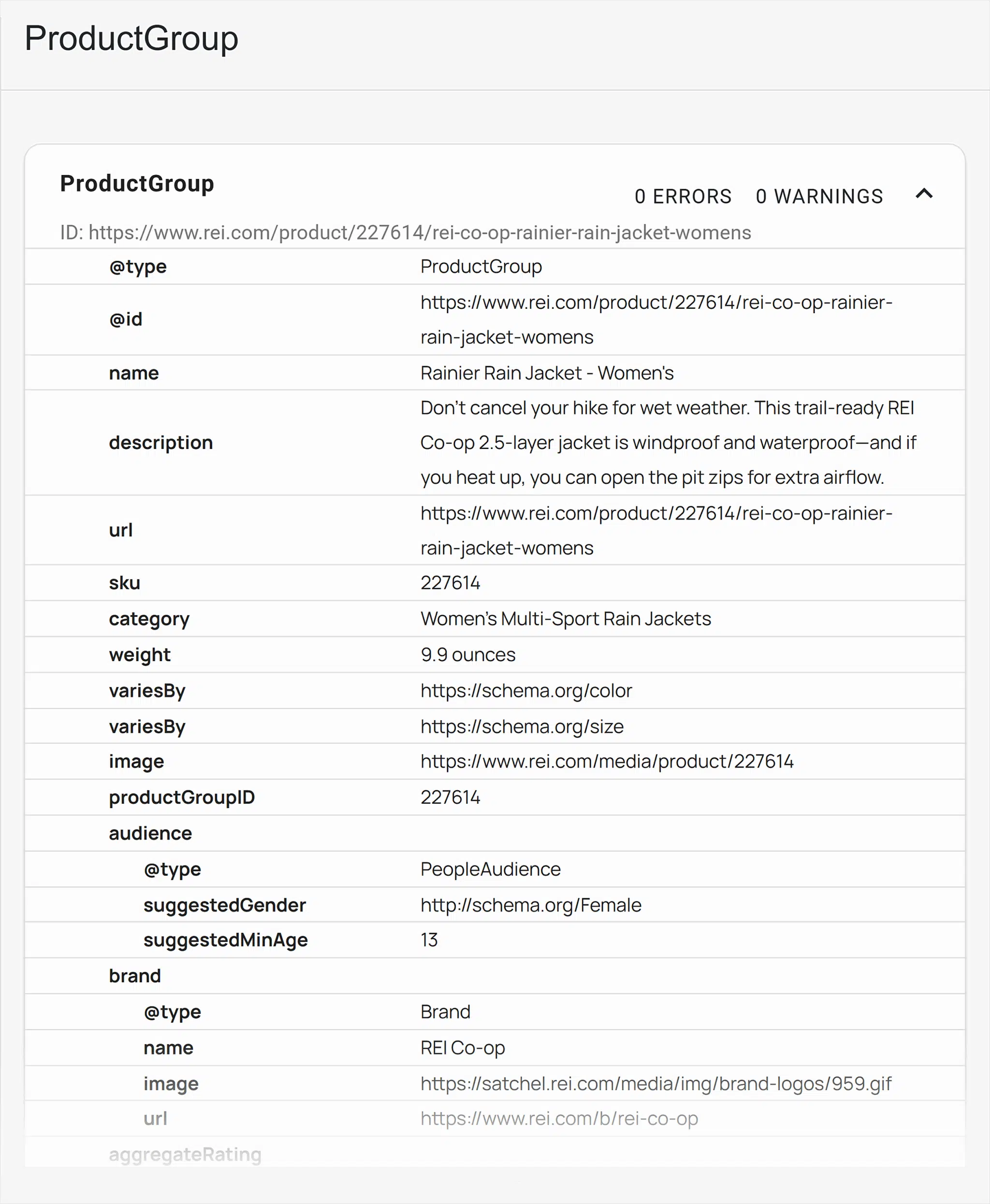
Choose a nested structure for product and category pages. This is an intuitive structure for both UX and search engine bot crawlers to navigate pages.
This structure should include descriptive keywords, not shorthand or numbers. Here’s an example of an insulated women’s rain jacket:
products/women/insulated-rain-jackets
This structure helps with long-tail organic visibility in SERPs.
Further reading: Category page optimization
Organic content marketing
Organic content marketing doesn’t have the immediate ROI of an effective ad campaign. But the long-term investment pays off with discovery, lead nurturing, and community investment.
Content marketing covers search engines and social media platforms. Some effective types of organic content marketing:
- Long-form website content: How-to content, competitor comparisons, shoppable blog posts, gift guides, and lookbooks.
- Short-form videos: Responses to social media comments, hot takes on trends, resharing UGC, and behind-the-scenes content.
- Long-form videos: Video tutorials, explanation of product features, competitor product reviews, and educational content related to your niche.
Here’s an example from REI. Googling “how to adjust a hiking backpack,” the user is directed to REI’s blog with the first search result:
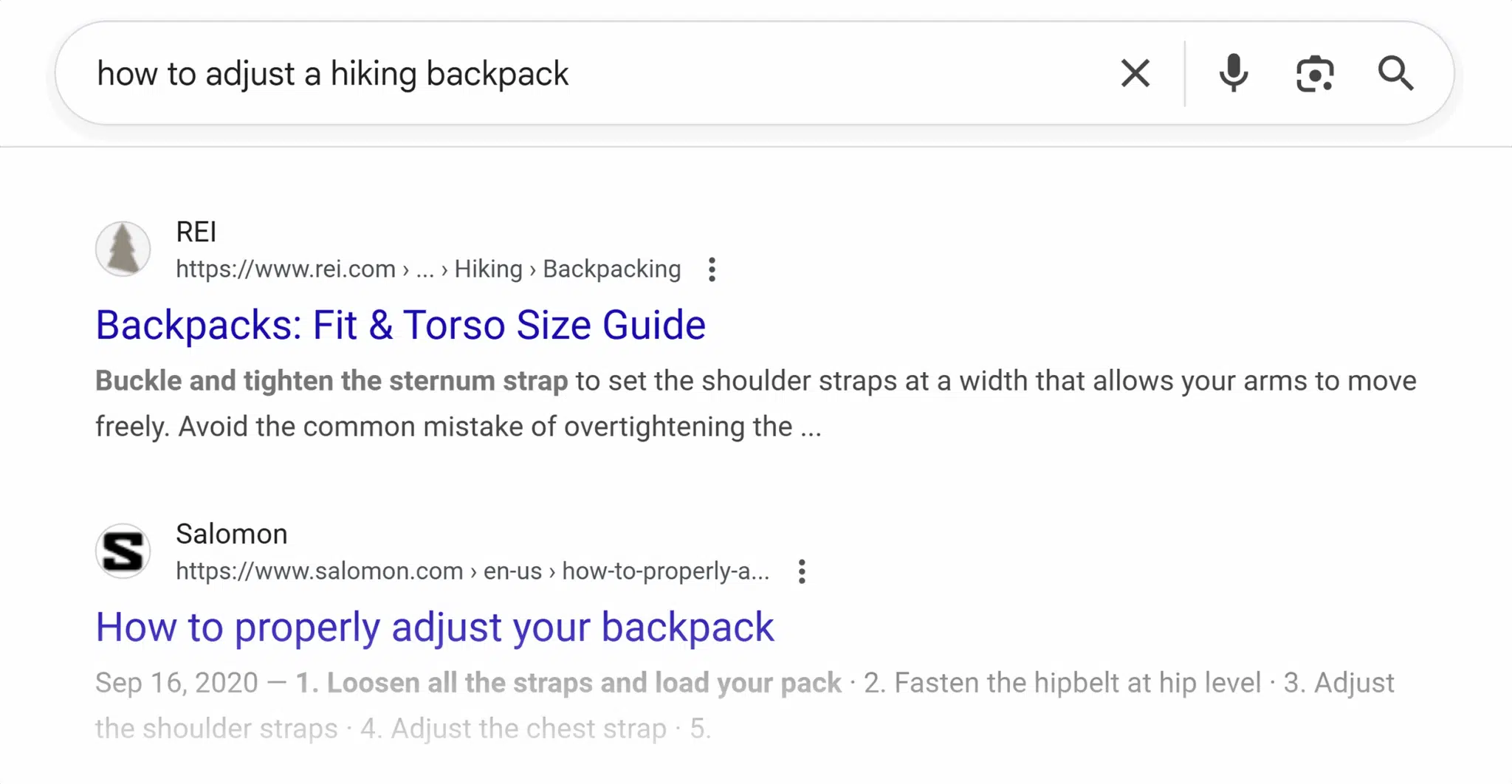
Once on REI’s website, they are encouraged to move over and browse related products in their shop:
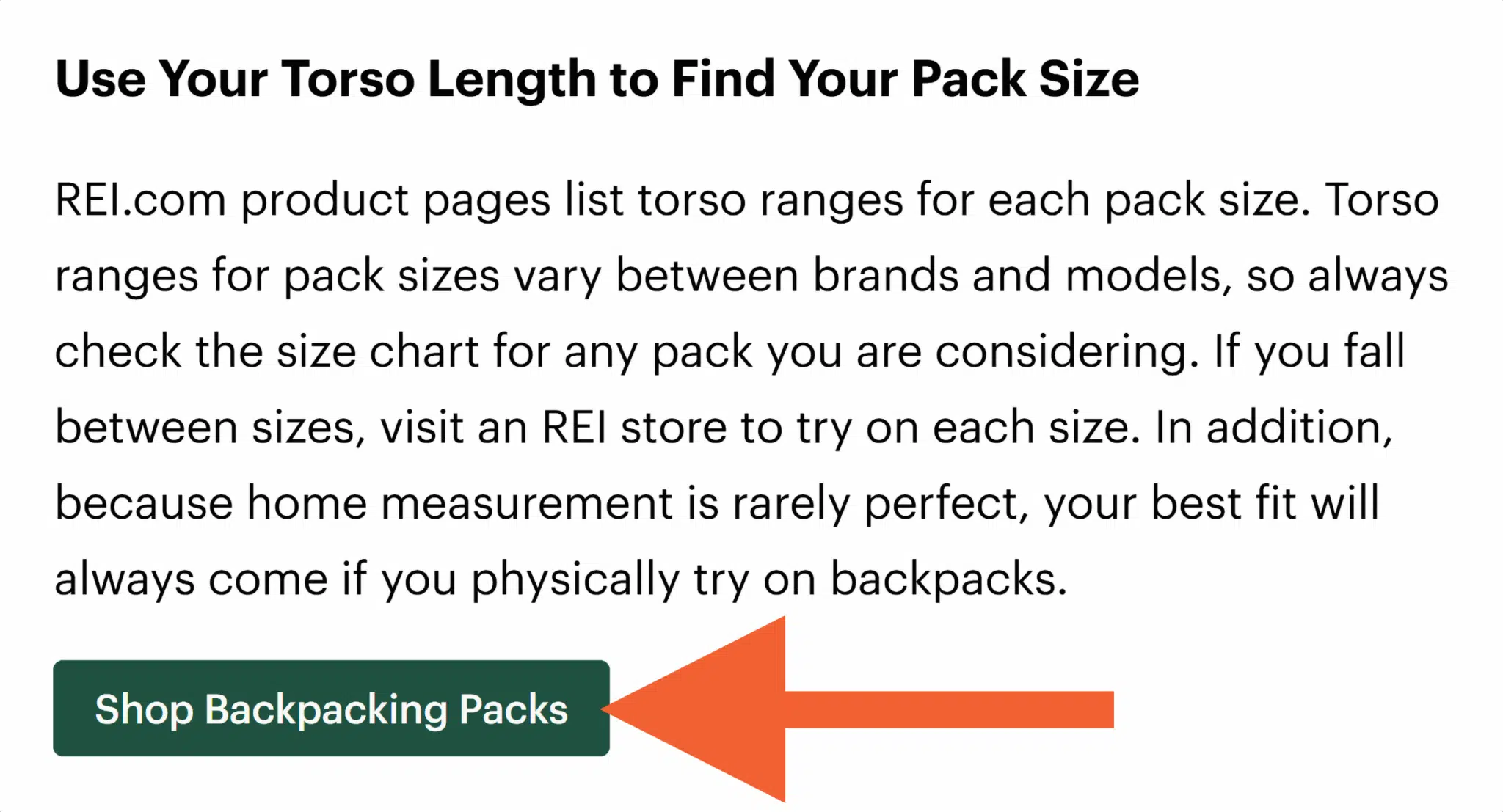
This bridges search with conversion.
AI referrals
AI platforms, like ChatGPT, drive organic traffic to crawlable websites by including links in chat conversations with users.
While still relatively new, ecommerce referrals from AI have risen more than 700% in the past year, according to Storeis data.
AI optimization is different from search engine optimization. The fundamentals include allowing AI crawlers onto your website and intentionally structuring data so they understand it.
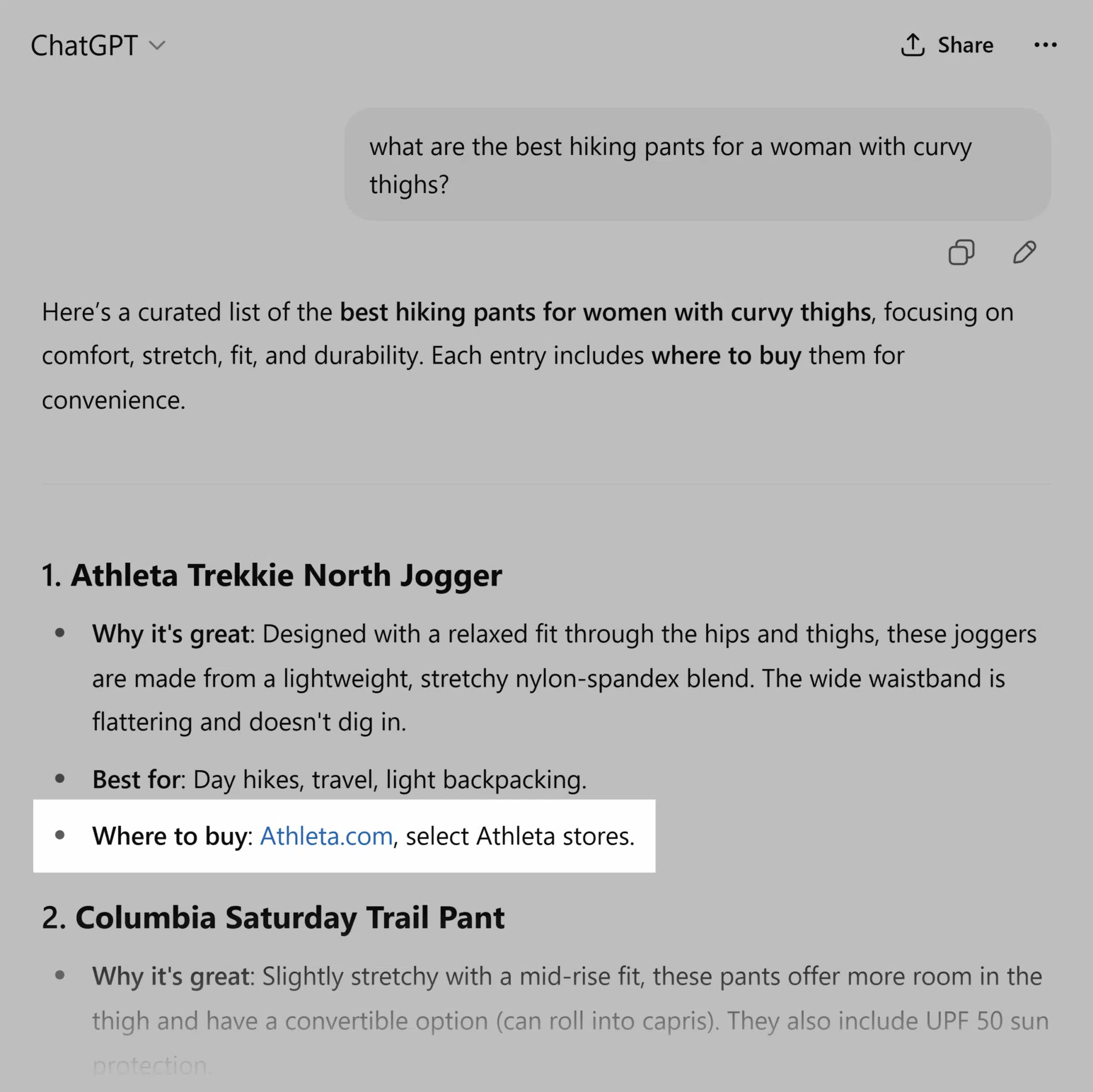
Further reading: AI optimization
Branded search
Branded search converts better than generic search and signals strong awareness. It’s the result of consistent branding, awareness, and clear positioning.
- Generic search: “Running shoes women.” Competitive. Lower conversions.
- Branded search: “HOKA running shoes women.” Direct. Higher conversions. Good for SEO.
The most common branded searches are questions. Uncover questions about your brand with the tool Answer The Public.
Here’s an example for the brand Liquid IV, where 122 searches were revealed:
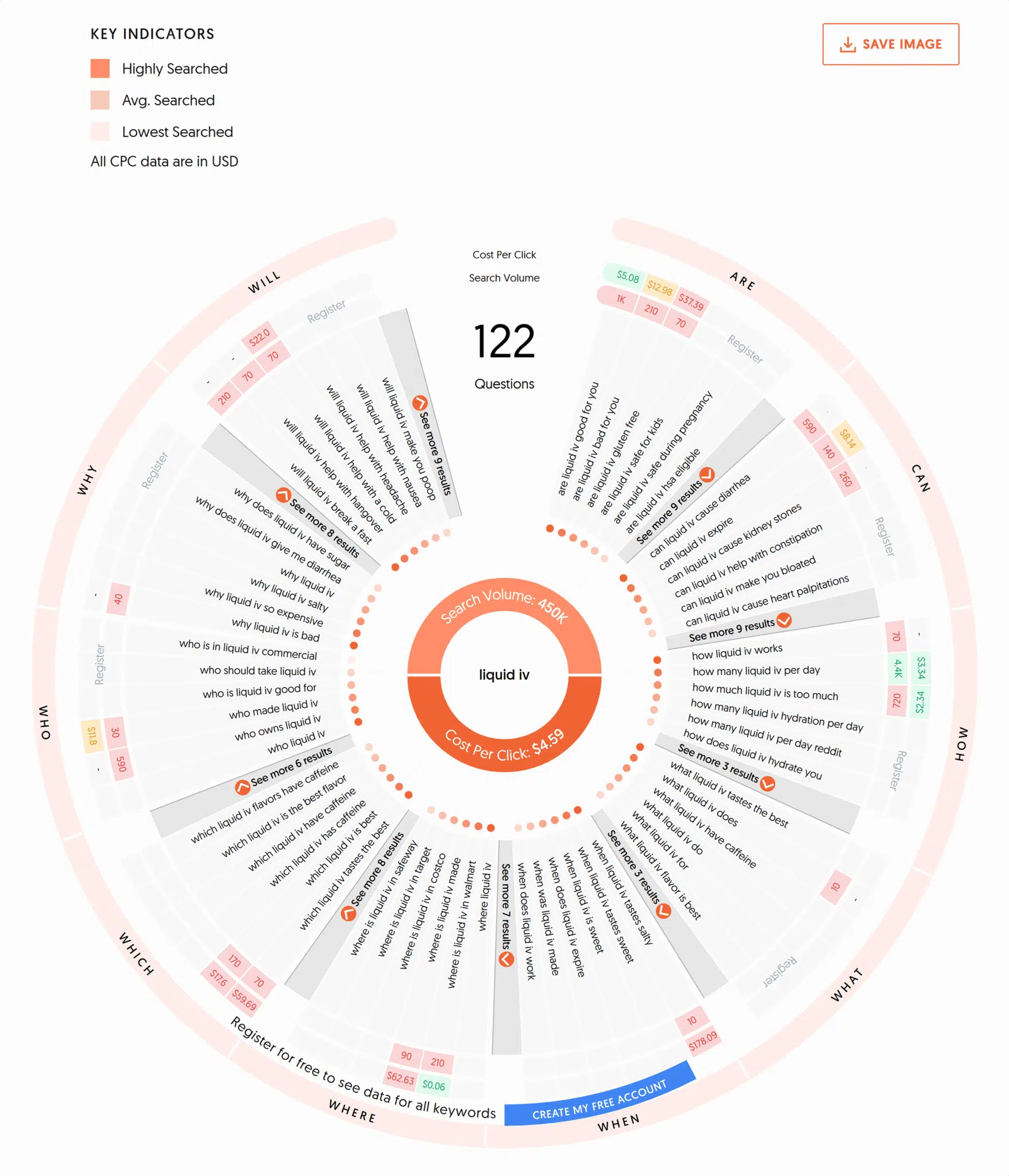
A unique selling proposition (USP) and community investment lead to this type of customer recognition. But a brand needs to be unique to achieve this.
Clarity on your USP will help you improve your ecommerce conversion rate.
Ecommerce conversion rate optimization (CRO)
Optimizing PDPs for SEO gets people onto your website, and optimizing for UX gets them to convert. The reality is that most viewers will leave your virtual storefront without making a purchase.
Brands have to build trust through optimized PDPs, checkout flows, and good design to earn purchases.
Optimizing PDPs for UX
A PDP page needs to answer two questions in order to convert viewers to buyers: Does this product meet my needs? Can I trust ordering from this website? Everything on the PDP should guide customers towards saying yes.
Customers need trust, ease, and clarity to convert. These factors are represented in your design choices.
- Trust: Company contact information, clear return policies, secure payment options, etc.
- Ease: Mobile formatting, fast load times, clear shipping information, etc.
- Clarity: Product features, images, videos, etc.
You can observe these optimization elements on Amazon, the biggest online retailer:
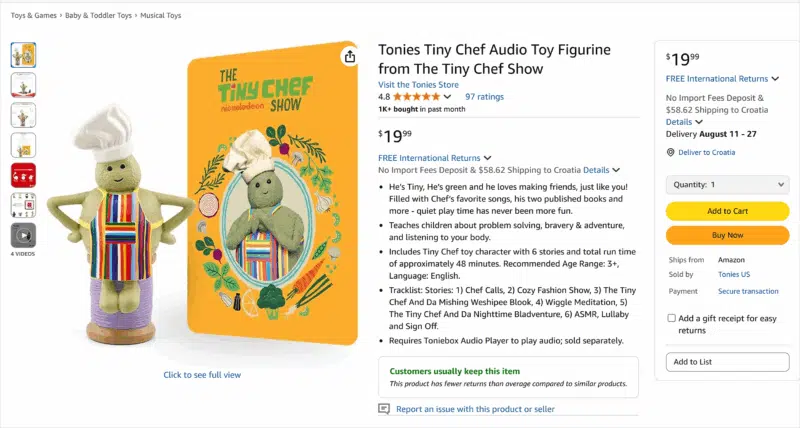
Trust-building elements
Showing trust signals will improve ecommerce conversion rates. This is achieved through your product, website, social signals, industry authority, and personalization.
- Product: Clear information, multiple pictures, FAQs answered
- Website: Secure payment page, clear store policies, guarantees (satisfaction, money back, etc.)
- Social signals: Reviews, testimonials, case studies, UGC content, number of units sold
- Industry authority: “As seen in” badges, awards, recognition
- Personalization: Geo-specific information (like display language, shipping estimates), relevant upsells, “recently viewed”
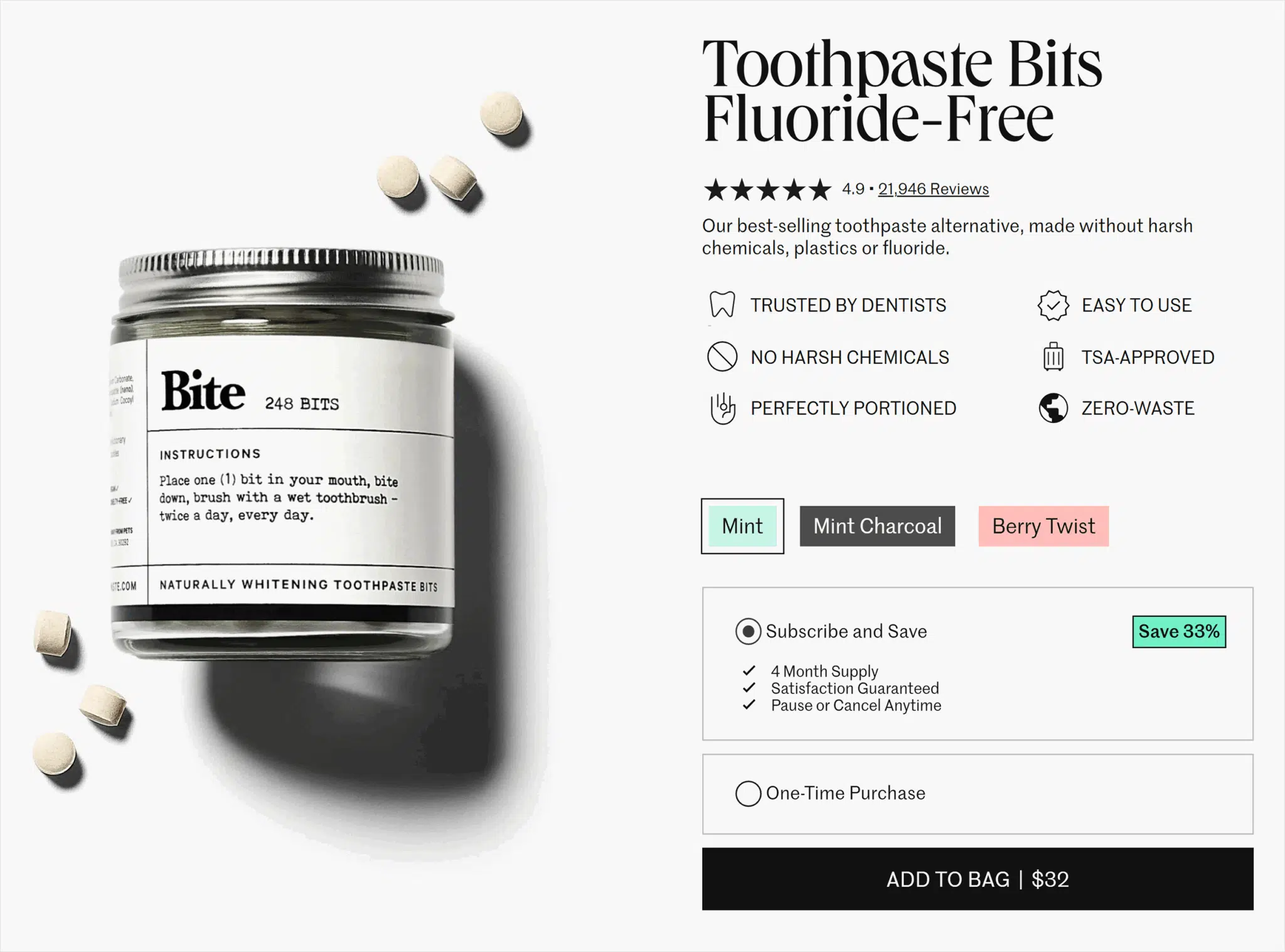
Consider what trust signals are needed for different points of the customer journey. For example, ads targeting cold leads will need more context about your product than returning customers.
You may ultimately create multiple product pages for different segments of your audience to serve this purpose.
Optimizing checkout flows
Optimize checkout flow and reduce cart abandonment by removing unnecessary customer steps and decisions.
Even at the last minute of the sales process, cart abandonment occurs. Research from SellersCommerce found that 70% of all online shopping carts were abandoned in 2024. The top reasons were additional charges (48%) and mandatory account creation (26%).
Reduce the number of clicks in the checkout process. Anticipate the most common conversion barriers, such as surprise fees or delivery concerns, and address them directly in the checkout experience.
For example, the Lady M bakery anticipates customer concerns about fresh cake delivery and speaks to this on their checkout page:
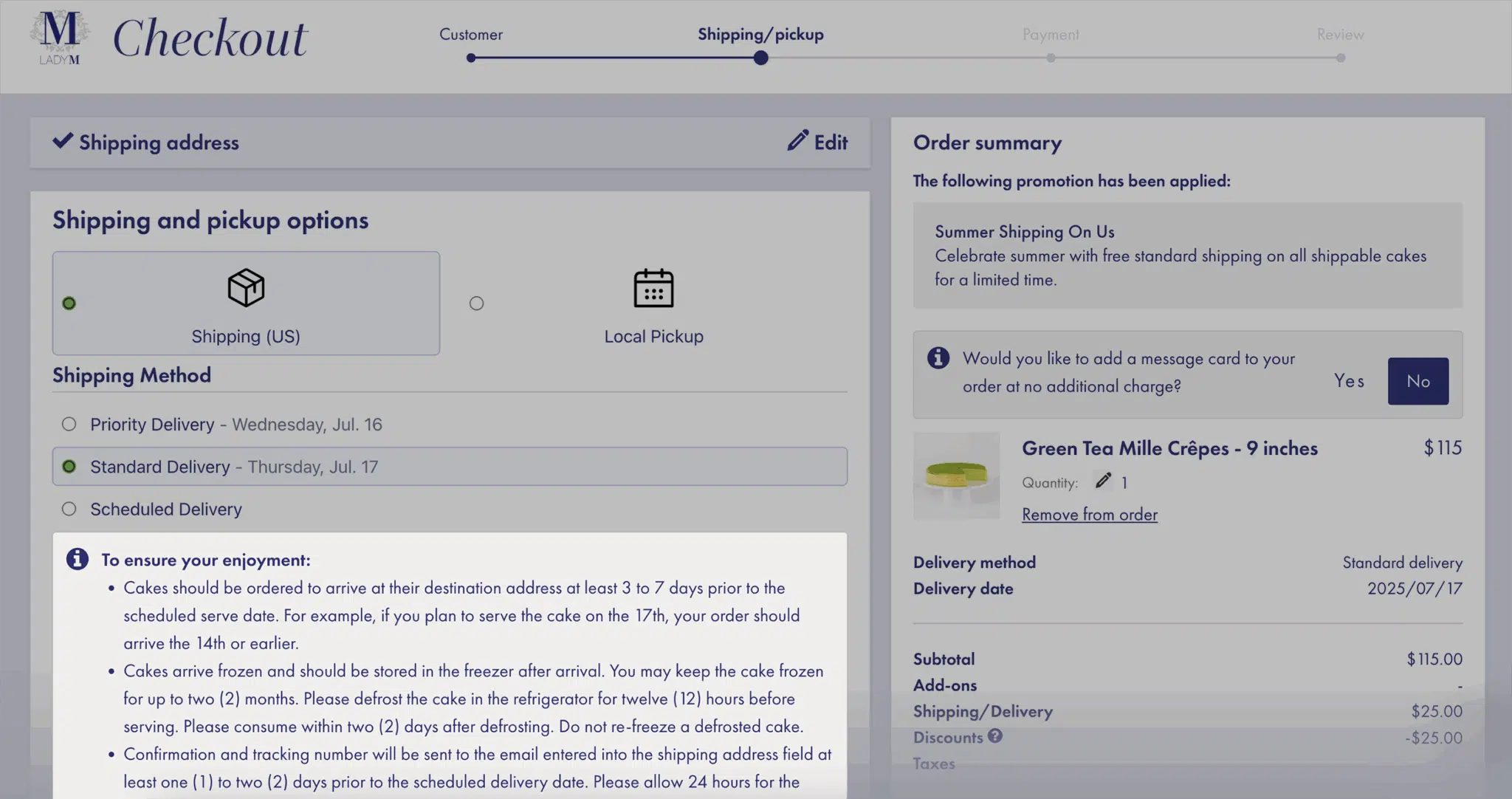
Discover optimization opportunities by analyzing how customers interact with your checkout flow. A few tools that can reveal silent, unsolicited customer data are:
- Scroll maps
- Clickmaps
- Heatmaps
Find bottlenecks in your checkout process to understand where sales are lost. Testing is key to success.
Testing framework
Your product pages are never done. Even the perfect page needs testing and updates to stay relevant as products and user behavior evolve. A/B testing can be applied to many elements:
- CTAs: Placement, color, and message
- Pop-ups: Timing, content, and offer
- Images: Polished professional photography, UGC, and video
- Discount codes: Both store-wide sales and influencer-specific promotions
Creative testing isn’t all done manually. AI software can automatically employ its own testing framework on your shop. But manual review on desktop, tablet, and mobile will highlight separate issues from A/B testing.
Elements like spacing and visual hierarchy (such as CTA size) need to be customized for each device type. Mobile testing is easily neglected. Conversion rates on mobile are consistently lower than on desktop.
Checkout rates should be checked daily or weekly to identify when new problems arise. For example, a sudden drop in check-outs can alert you to an unexpected checkout page loading issue.
Retention marketing
Retention increases LTV and reduces reliance on acquisition. It’s where ecommerce brands find long-term growth.
Gorgias’ customer data found that repeat customers account for 44% of revenue, despite only representing 21% of the customer base.
Email & SMS
Email and SMS marketing offer direct access to customers without relying on algorithms.
Compare it to social media marketing, which holds big risks:
- You don’t own your following on any social platform
- Viewers are distracted by your competition
- Algorithms are out of your control
The threatened TikTok bans put this risk into perspective for many businesses. Funneling viewers to owned marketing channels protects your connection to your audience.
Then, you can target those customers with:
- Abandoned cart messages: Discounts and scarcity messages
- Post-purchase support: Updates on shipping, product adoption tips, and direct access to customer support
- Win-back campaigns: Cross-sells, limited-time offers, and personalized recommendations
- Lifecycle flows: Nurture new customers and acknowledge milestones
Direct lifecycle marketing can also help reinforce the shared values. For example, a plastic-free laundry detergent brand could celebrate how many plastic bottles a customer has avoided after six months of using their product.
The most common example of milestone marketing is probably birthday well-wishes:
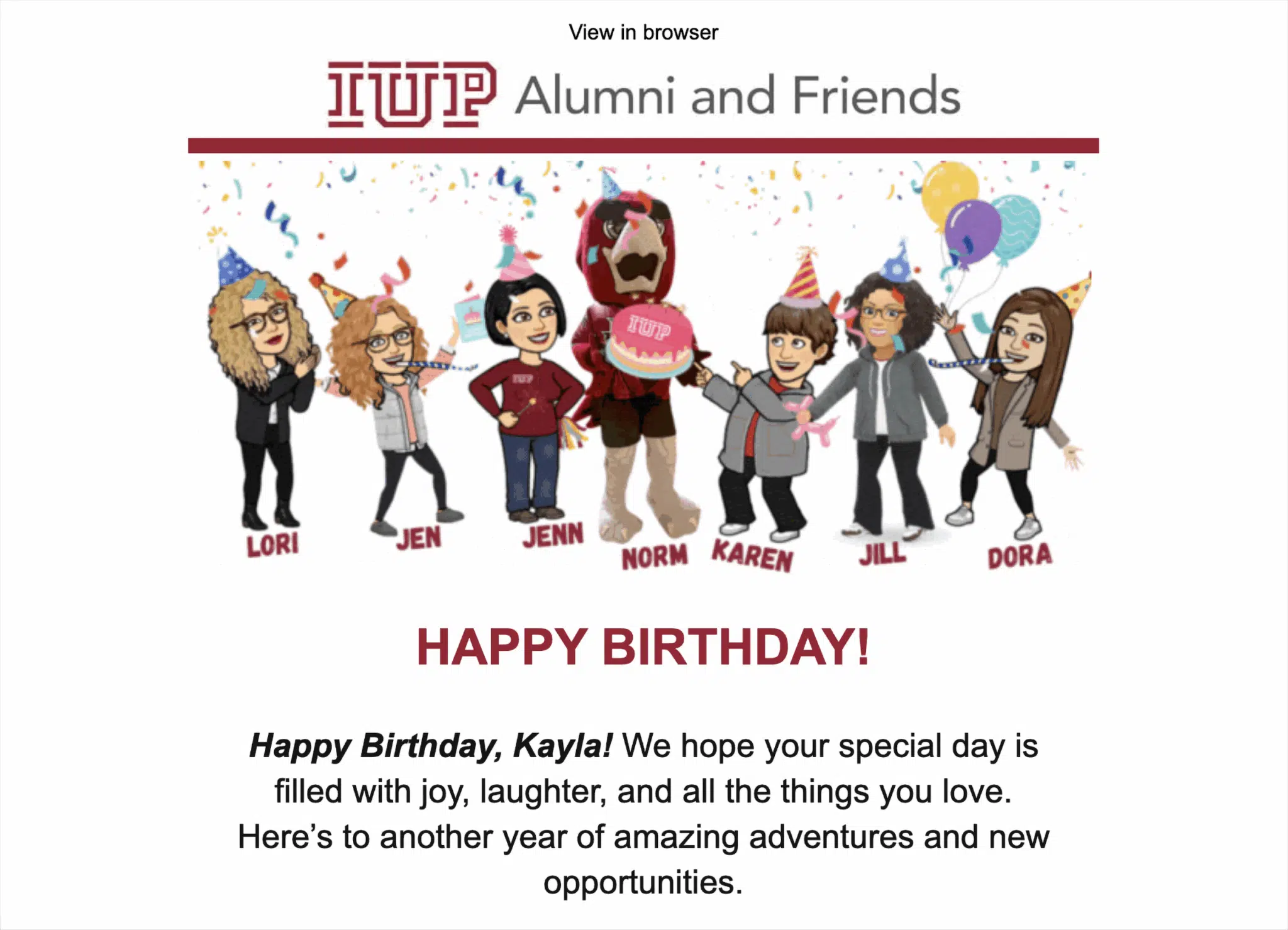
Loyalty and referral programs
Loyalty programs reward customers for repeat purchases. Customers earn points, credits, or punches on a virtual punch card for each purchase.
Referral programs encourage customers to share your brand with their network, amplifying reach and converting word-of-mouth into measurable revenue.
These programs are sometimes bundled together, but referrals have a heavier community focus.
One loyalty program example comes from skincare brand Barefaced, called the No Sun Club. It’s run through Yotpo, and reportedly increased revenue from loyalty redeemers by 69%. Company values and brand building are bundled into the copywriting on the sign-up page:

An example of an ecommerce referral program is nutrition brand Jimmy Joy. Their program, run on Smile.io, reportedly drove more than $1 million in referral revenue.
These programs can be bundled with subscription models for even more revenue impact.
Subscription models
Subscription models drive recurring revenue and increase LTV when paired with the right product and fulfillment setup.
Subscription model popularity has exploded in recent years. Some examples include:
- Consumable products like dog food, protein powder, or vitamins (like Cuure)
- Replenishable products like deodorant, cleaning products, or craft supplies (like Sketchbox)
- Digital products like TV shows, software, or even new music (like Brain.fm)
Customer incentives are key for subscription models. This can range from discounts to the benefit of making customers’ lives easier.
Here’s an example from ecommerce marketplace Chewy. This brand knows that no one likes running out of dog food. They position their subscription offer as an “autoship” feature, speaking directly to a customer pain point:
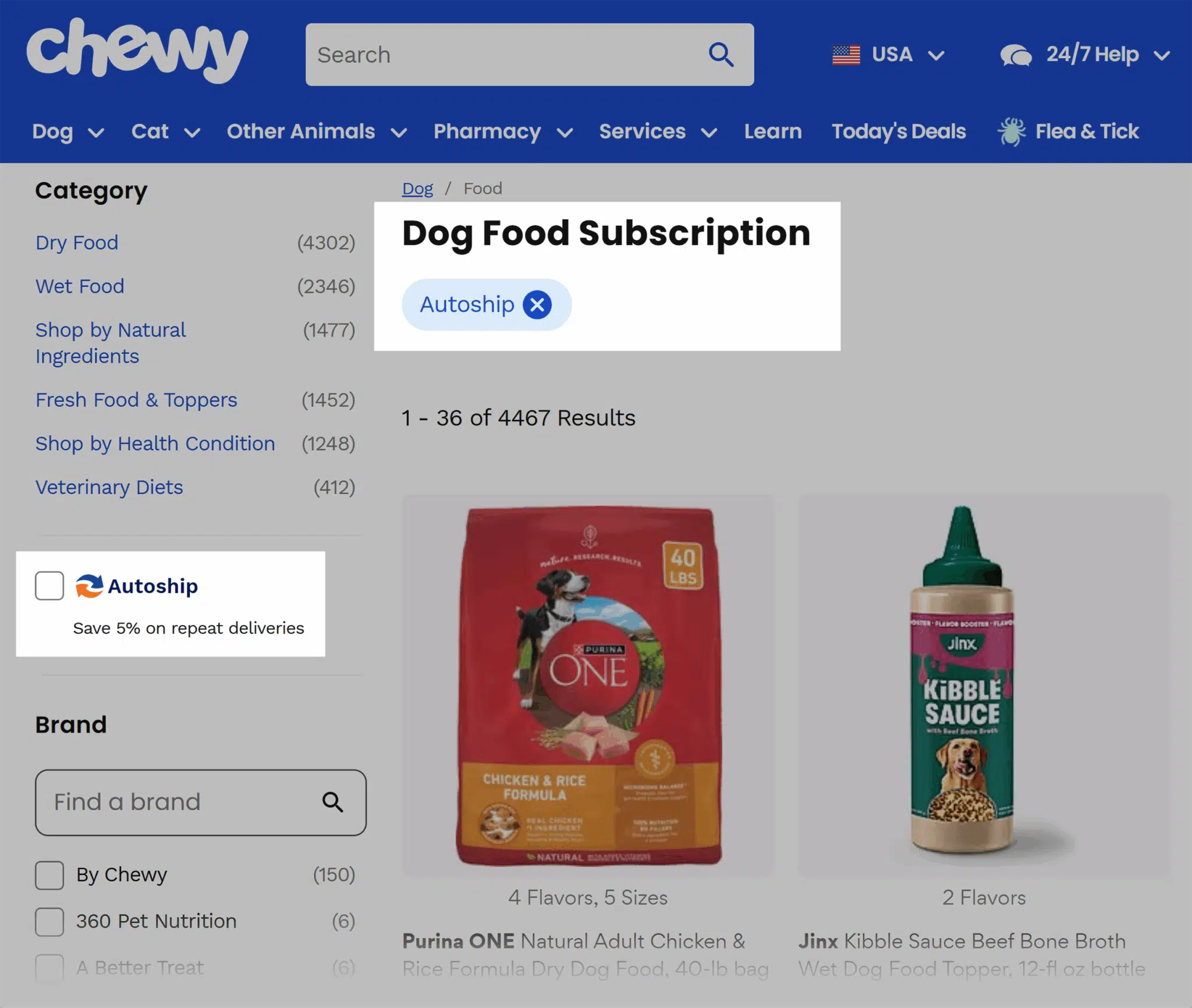
All of these retention attempts are driven home with effective segmentation and messaging.
Segmentation and behavior-driven messaging
Segmentation and behavior targeting help you to personalize marketing efforts.
Behavior-driven marketing is initiated by a customer action. Use browsing and purchase behavior to predict intent. Segment audiences accordingly for personalized outreach.
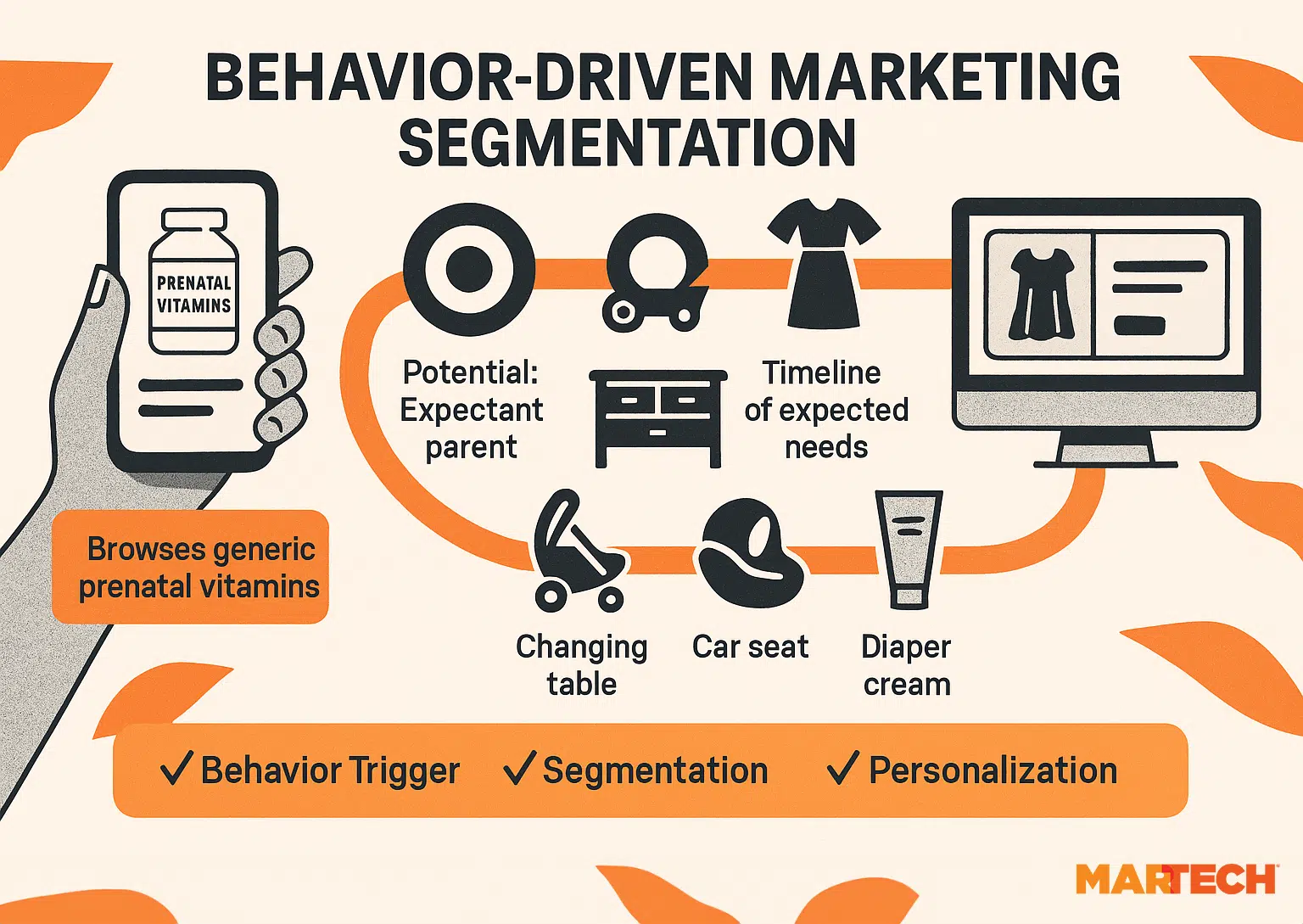
Ecommerce personalization
Onsite personalization boosts conversion rates by aligning content and offers with customer behavior.
Tool-based personalization
Personalization tools dynamically gather, analyze, and act on customer data to produce the highest conversion rates. Tools offer targeted discounts, upsells, and bundles that are positioned based on browsing history, location, etc.
Some personalization tools include:
- Nosto: Uses predictive AI to anticipate which products a customer has the highest odds of buying
- Rebuy: Known for its AI Smart Cart™ feature that customizes user experiences to reduce cart abandonment and increase AOV for Shopify stores
- Dynamic Yield: Offers advanced A/B testing and scalable personalization
- If-So: Has plug-and-play code-free website customizations, like using a customer’s county, name
A simple example of website personalization is an ecommerce business using If-So to offer a first-time website visitor a welcome discount.
An advanced example is a business using Nosto to analyze a customer’s browsing behavior in real-time and recommend the products they’re most likely to purchase.
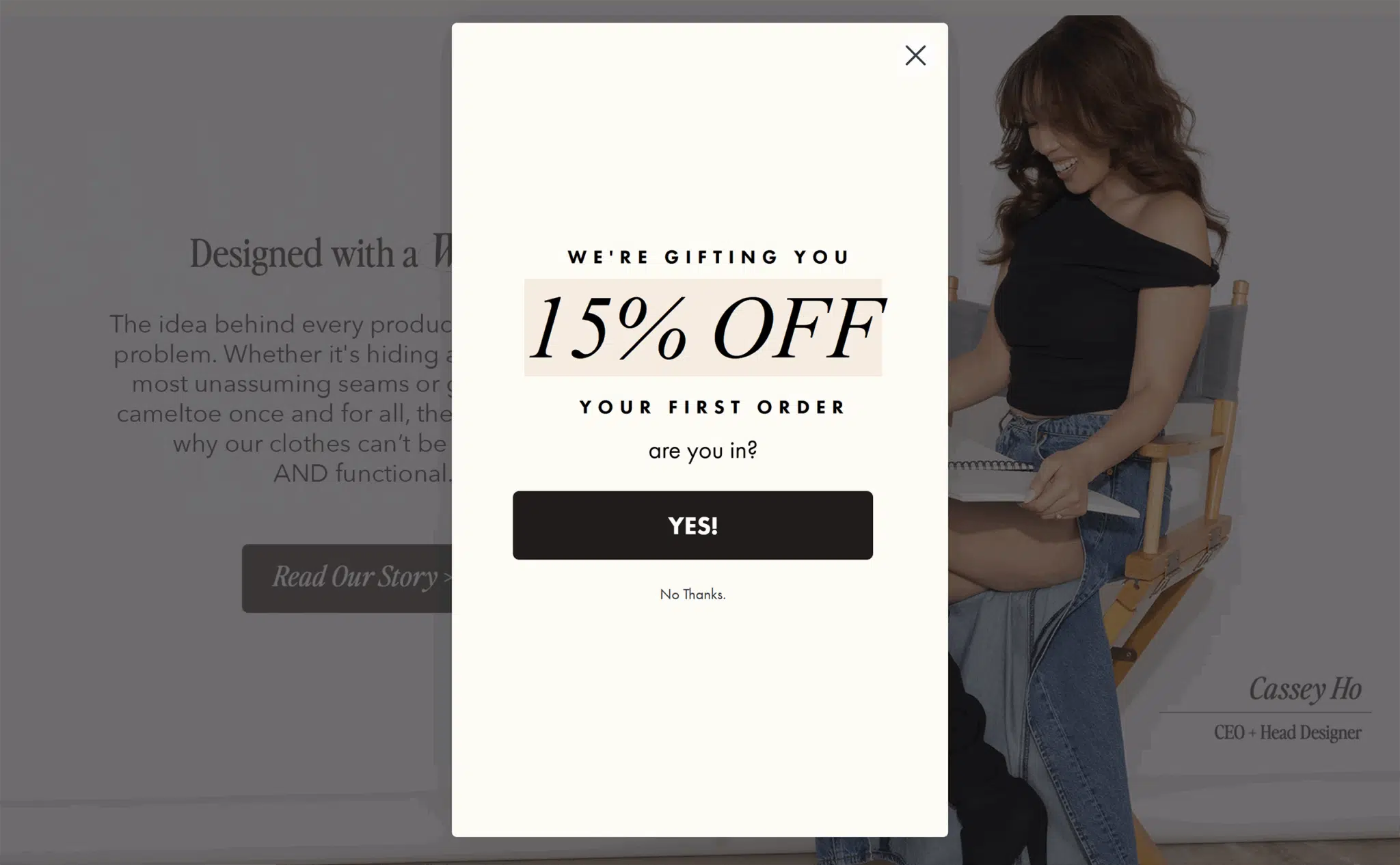
Ecommerce use case: The #1 cause of abandoned carts is unexpected costs (shipping, tax, etc.) Use a customer’s location to estimate these expected costs and reduce cart abandonment.
Product-based personalization
Tailoring the shopping experience based on product details (size, price, etc.) can increase conversions by reducing options that are irrelevant to the shopper.
For example, a skincare brand may ask a user for their skin tone and then only show products available in that shade.
Browsing behavior-based personalization
Use customer data platforms (CDPs) to unify behavior across touchpoints, such as email, search, and on-site actions. Personalization tools like Nosto then tailor content based on this behavior, such as recommending trending products to return visitors or surfacing region-specific offers.
These segments range from basic to advanced, like:
- What product page or blog post a visitor entered the site on
- Visitors coming from Google or an email blast
- New visitors versus returning visitors
You can design your dynamic browsing experience to be undetectable, or you can make the personalization apparent to viewers.
For example, after several visits to Twilio Segment’s website, a bot acknowledged that it had tracked a customer’s visits and initiated a conversation:

The power of these ecommerce personalizations all comes down to your customer data.
Unifying data and attribution
Strong attribution and data insights are essential for maximizing ROI. As third-party data becomes less reliable, ecommerce brands need to build resilient, first-party data strategies.
First-party data strategy
With third-party data less reliable, brands need to build robust first-party data systems to gauge marketing success.
A first-party data strategy relies on data from your own channels, like your own website, email list, loyalty program, surveys, etc. Rather than tracking client-side through their browsers, marketers now track first-party data server-side.
This includes both solicited data that customers voluntarily provide (like surveys) and unsolicited data (like browsing behavior). Solicited data collection can fold directly into your other marketing efforts.
When selling on third-party platforms like Amazon, brands lose access to critical first-party data. Owning your ecommerce site allows you to capture email addresses, track behavior, and run personalized campaigns.
Platform-specific tools can help. For example, you can connect ad platforms with Shopify or BigCommerce through server-side tagging to help bridge gaps.
Here’s a solicited first-party data example from The Bump, where they invite users to self-segment in a website pop-up:
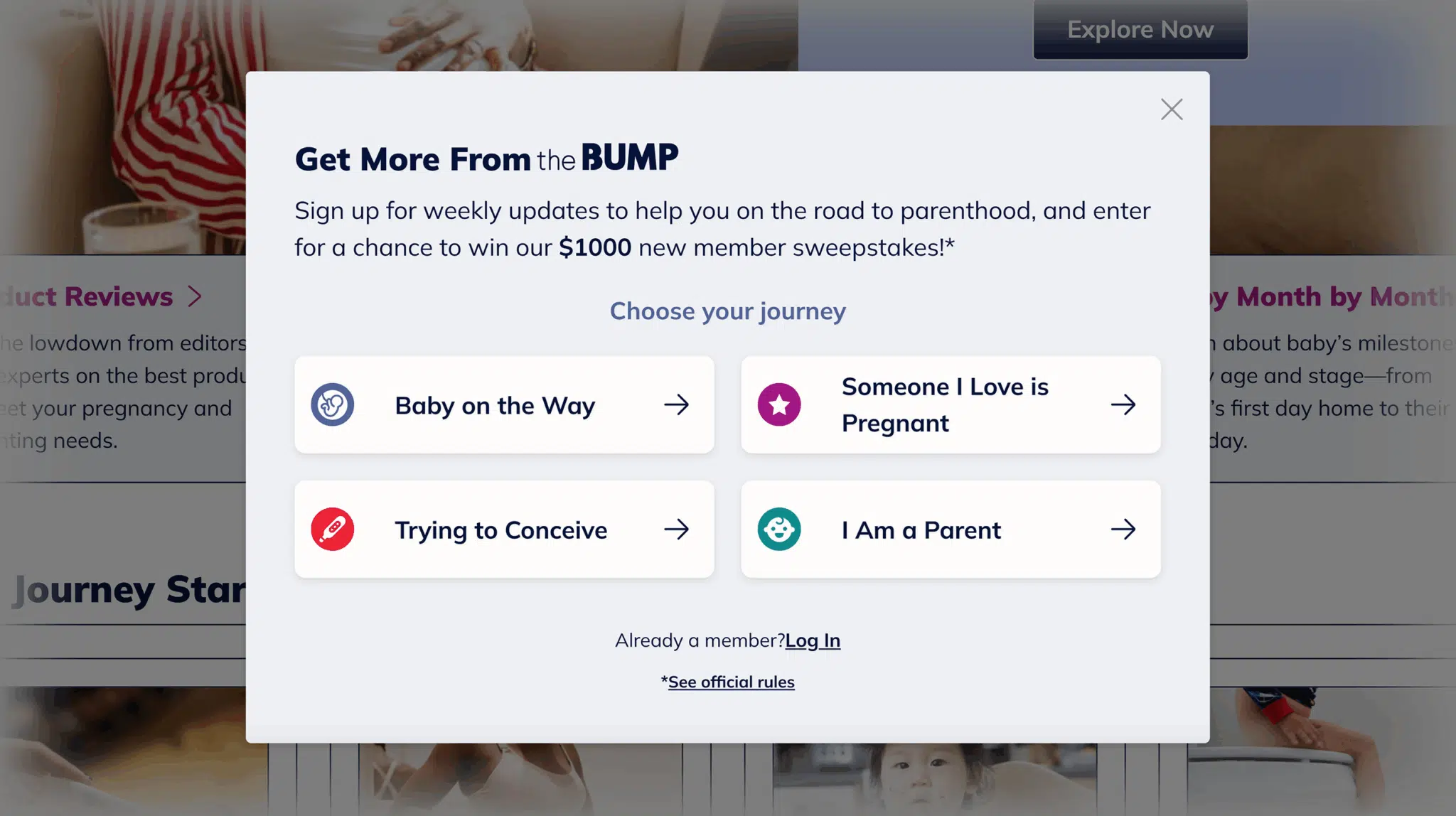
Barefaced does this as well, while offering a discount code to engage customers:
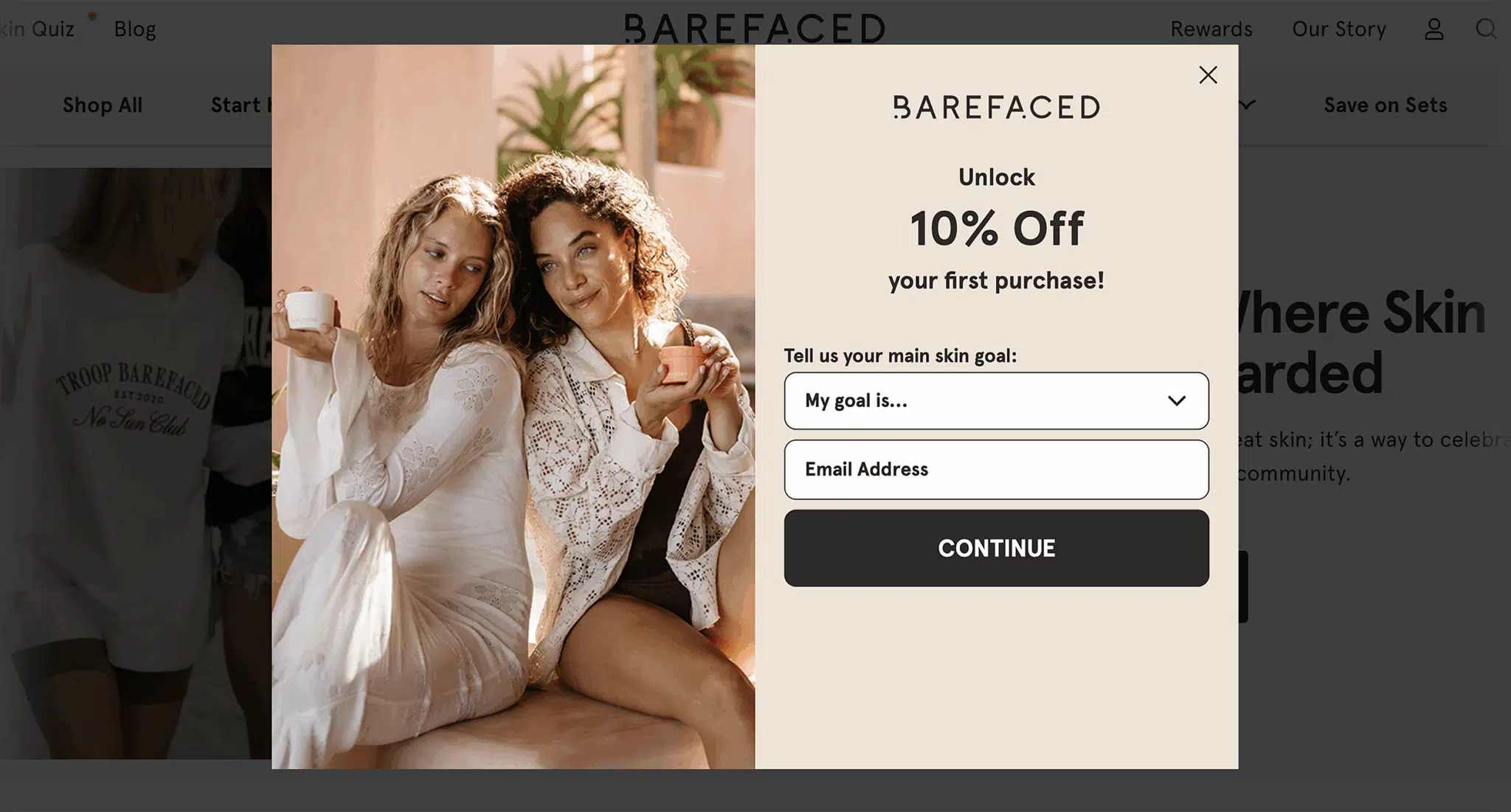
These are basic examples of the shifts away from third-party data in pursuit of pixel independence.
Ecommerce attribution modeling
Attribution modeling helps businesses understand where sales originate and adjust their marketing budgets accordingly for maximum ROI.
Understanding where sales are coming from is difficult for two reasons:
- Too many touchpoints: The customer journey takes place on too many platforms and they’re not all trackable.
- Sale credit unclear: Who gets credit for a sale? The touchpoint where the customer learned about the product? Or the final touchpoint before making a sale?
Modern, specialized attribution tools help map out the customer journey and use AI to create a model of customer behavior.
Tools and frameworks
Use attribution tools and performance frameworks to make data actionable and guide investment.
Tools like Triple Whale and Northbeam collect your first-party data from diverse channels, then use AI to estimate the customer journey.
- Northbeam connects multi-channel data to model customer behavior.
- Triple Whale offers detailed data collection as well, with a specific focus on Shopify stores.
Despite being based on an artificial model, these tools bring you significantly closer to a full understanding of customer behavior.
A free, general analytics tool is Google Analytics 4 (GA4). It provides some insights into conversion rates, but it lacks the customization that Northbeam and Triple Whale offer.
Painting a complete picture of your effectiveness involves a combination of data types:
- Return on ad spend (ROAS): Every dollar gained in revenue from a specific ad campaign. Doesn’t account for multiple customer touchpoints. Helps analyze individual ad performance.
- Marketing efficiency ratio (MER): Revenue generated for every dollar spent on marketing across all channels. Analyzes your marketing efforts as a whole. Helps with forecasting.
- Contribution margin analysis (CMA): Profits after taking all costs (like CAC, fulfilment, tariffs) into account. Measures profitability. Helps with scaling.
Analysis is the fourth section of the ecommerce marketing flywheel. All of your findings at this stage feed back into stage one, customer acquisition, helping you improve and scale your strategy.
Start optimizing for conversions
Conversion starts with clarity and trust. Use these strategies to optimize your ecommerce funnel, from product page to post-purchase.
Refine your PDPs and checkout flows to turn browsers into buyers and build loyalty beyond the first sale. The data you collect in the process will provide insights that will inform your UX and help you maximize your marketing ROI.
The success of your ecommerce marketing lies in your ability to track, follow, and act on data. Learn more about how to do this in our ecommerce analytics guide.